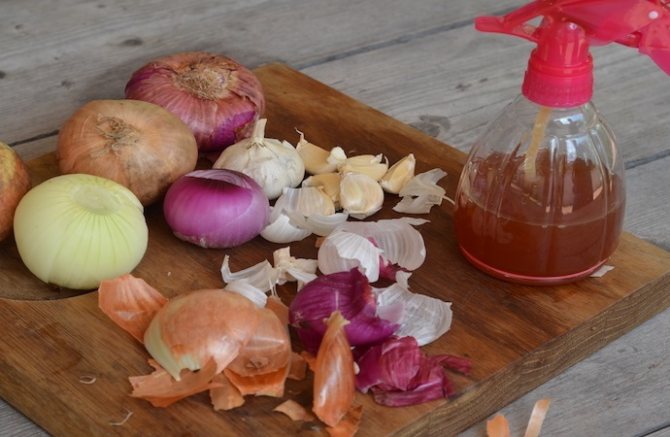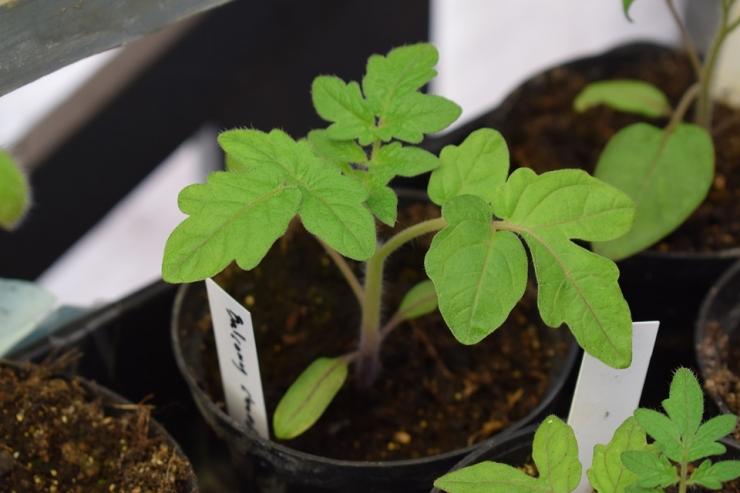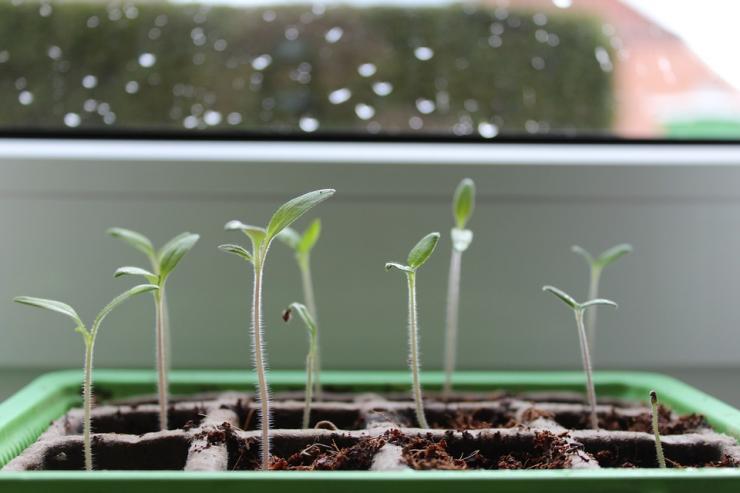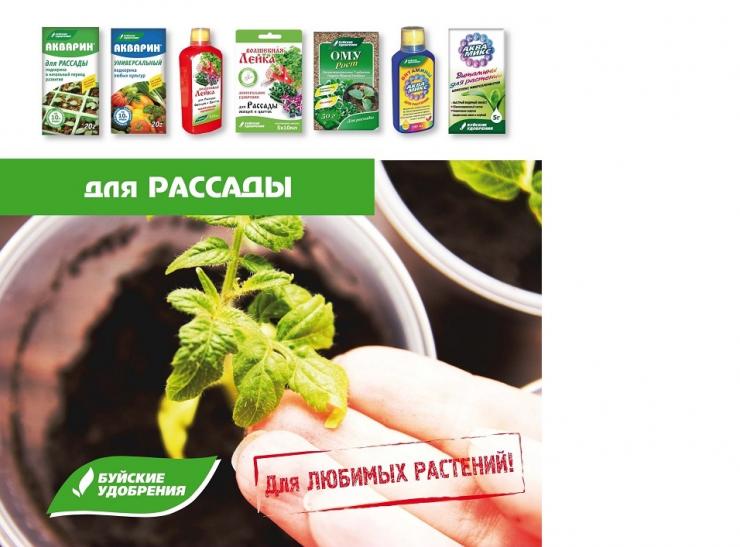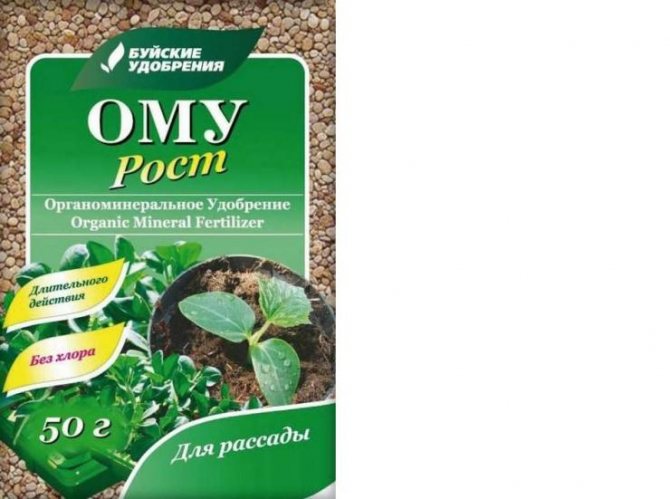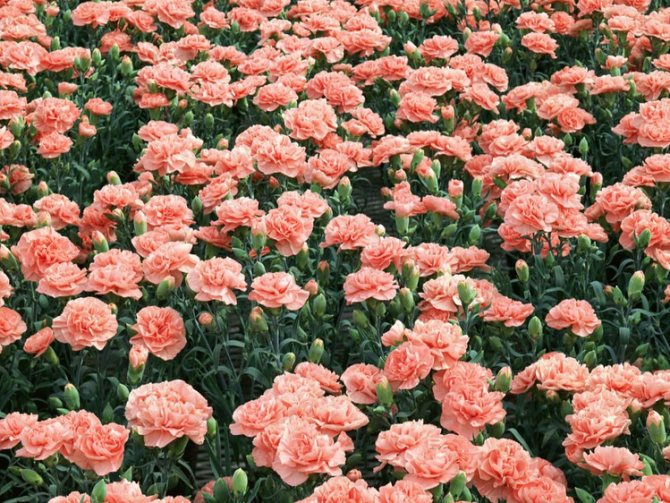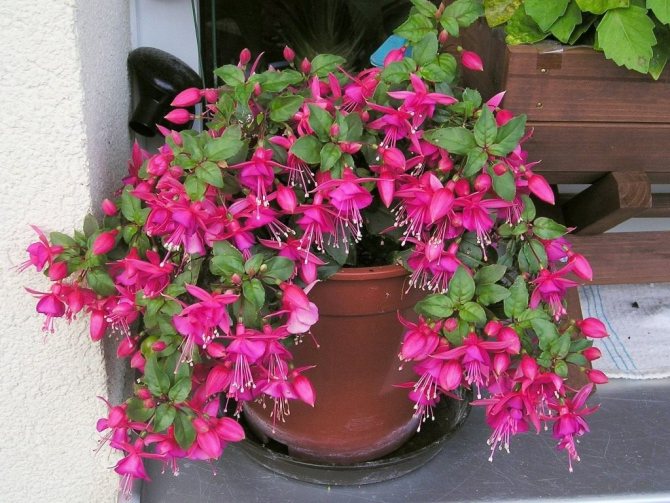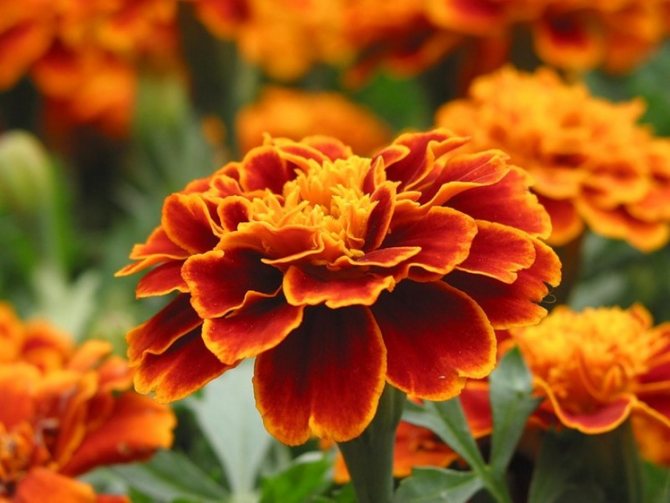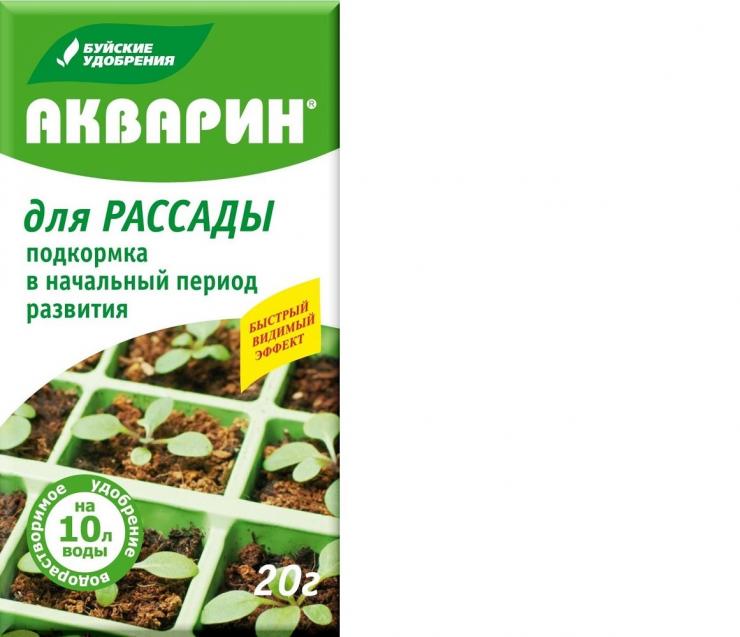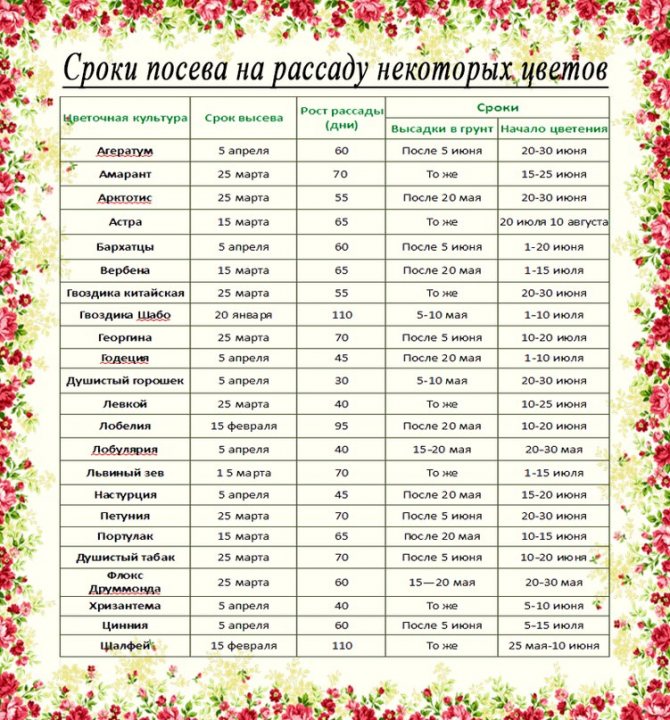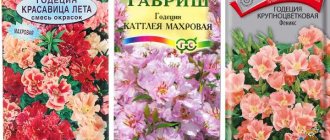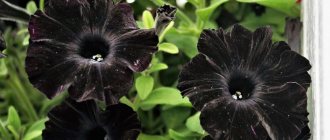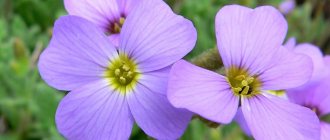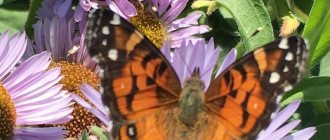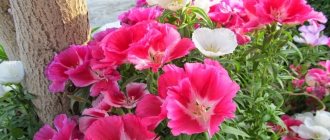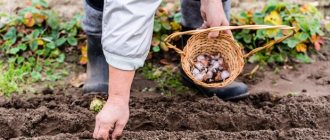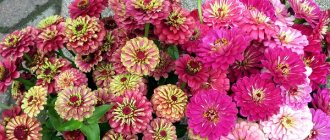How to grow flower seedlings at home
It was very difficult to grow seedlings at home 50 years ago. Central heating was not everywhere, it was impossible to find seedling containers on sale, and the area of the windowsills did not allow installing many pots. Now everything has changed. In apartments, the same temperature is almost always maintained, the wind does not blow from plastic windows on delicate sprouts, and there is enough space on modern window sills to organize a small home flower bed. Therefore, any amateur can grow seedlings of any flowers today.
Priming
Stores sell special seedling potting mixes. You can prepare such a mixture yourself by mixing sand and peat soil in a 1: 1 ratio.
Seedling containers
For germination of seeds, special seedling boxes are best suited. After the seedlings grow up, they should be dived into individual containers.
Seeds
It is very important to choose quality seeds. It is advisable to purchase those plants that grow in your latitude, or varieties that easily adapt to the new climate.
Time
Almost all reference books recommend starting sowing in February. But this advice, which appeared during the Soviet era, is already outdated, just like the methods of growing seedlings. In a modern apartment, seedlings grow quite quickly, so it makes no sense to sow before March. The optimal time for placing seeds in the ground is at the end of the first month of spring.
Preparation
Before sowing, it is necessary to decontaminate the seeds. Since flower seeds are very small in size, it is impossible to soak them in potassium permanganate. Disinfection can be carried out by dusting with a fungicide. To do this, you need to take a little dry preparation on the tip of a knife and pour it into a bag of seeds. Then the bag must be closed and shaken well. Sowing is done according to different methods depending on the type of plant. So, for example, petunia and lobelia are sown not in grooves, but directly on the surface of the soil, without sprinkling anything on top. Small seeds can also be mixed with river sand. For larger seeds, it is recommended to prepare grooves with a depth of 1 or 2 cm. The seed should be immersed in the ground to a depth of 3 times its height.
Seedlings
Until the emergence of seedlings, containers with crops must be covered with foil or glass. They should be kept at temperatures from +18 to +22 degrees. Every day, containers need to be opened for ventilation and the soil should be moistened with a spray bottle. As soon as the first sprouts appear, the glass or film must be removed immediately, move the container to a well-lit, warm place, continue to spray and start watering the seedlings. 2 weeks after the emergence of seedlings, the seedlings should be fed. If there is a lack of lighting, young seedlings need to be illuminated with a lamp. When 3 leaves appear on the sprouts, they should be picked into separate cups.
What to plant for seedlings in February
Active planting for seedlings starts in February. And although most of the summer people are still expecting an increase in daylight hours, this month you must not forget to sow some of the main favorites among the flowering crops. Good preparation in February ensures that your workload will decrease in March.
Crops that are sown for seedlings in February:
Lobelia
| Sowing dates | all February |
| Sowing depth | superficially mixed with sand |
| The soil | standard |
| Lighting | standard bright |
| Temperature | 22-25 degrees |
| Seedlings | from 10 days |
| Dive | double |
| Hardening | in two weeks |
| Landing in the soil | third decade of May - first decade of June |
| Landing distance | 15 cm |
| Difficulties | slow growth of seedlings |
Read our detailed material: "Growing lobelia from seeds"
Petunia
| Sowing dates | all February |
| Sowing depth | superficially mixed with sand |
| The soil | light sifted |
| Lighting | additional lighting is desirable |
| Temperature | 20-23 degrees |
| Seedlings | from 5-7 days |
| Dive | after the release of the second sheet |
| Hardening | preferably from April until disembarkation |
| Landing in the soil | second half of May |
| Landing distance | from 15 for multi-flowered to 30 for ampelous |
| Difficulties | prone to "black leg", miniature seedlings |
Read our detailed material: "About growing petunia seedlings in detail."
Fuchsia
| Sowing dates | early February |
| Sowing depth | 1 cm, by the piece |
| The soil | Standard |
| Lighting | bright, with supplementary lighting if possible |
| Temperature | 24-25 degrees |
| Seedlings | 10-15 days |
| Dive | do not conduct |
| Hardening | in two weeks |
| Landing in the soil | the end of May |
| Landing distance | 25-30 cm (in balcony containers - twice as thick) |
| Difficulties | needs to be formed |
Pelargonium
| Sowing dates | all February |
| Sowing depth | 3-5 mm |
| The soil | peat or peat with sand |
| Lighting | Bright |
| Temperature | standard room |
| Seedlings | in 2-3 weeks |
| Dive | at the stage of 2-3 leaves |
| Hardening | preferably from April until disembarkation |
| Landing in the soil | May |
| Landing distance | 10-25 cm |
| Difficulties | does not arise |
Balsam
| Sowing dates | all February |
| Sowing depth | 3 mm (covered with calcined sand) |
| The soil | Standard |
| Lighting | standard bright |
| Temperature | 23 degrees |
| Seedlings | Up to 3-4 weeks |
| Dive | after the appearance of the second pair of leaves in individual pots |
| Hardening | from the end of April |
| Landing in the soil | third decade of May - first decade of June |
| Landing distance | 25-30 cm |
| Difficulties | moisture-loving and tendency to fungal diseases |
Heliotrope
| Sowing dates | all February |
| Sowing depth | 3-5 mm |
| The soil | Standard |
| Lighting | bright standard |
| Temperature | 22-23 degrees |
| Seedlings | 3-4 weeks |
| Dive | at the stage of 5-6 leaves |
| Hardening | week before landing |
| Landing in the soil | end of May - June |
| Landing distance | 15-20 cm |
| Difficulties | heterogeneous bushes and shallow blooms (compared to cuttings) |
Sage brilliant
| Sowing dates | all February |
| Sowing depth | 3-5 mm |
| The soil | Universal |
| Lighting | standard bright |
| Temperature | standard room |
| Seedlings | 10-15 days |
| Dive | double (2-3 and 5-6 leaves) |
| Hardening | the longer the better |
| Landing in the soil | the beginning of June |
| Landing distance | 20-25 cm |
| Difficulties | weak seedlings in the absence of a second pick |
In February, you can sow lavender and other perennials for seedlings, the seeds of which have completed stratification or do not need it.
Throughout the month, you can continue sowing "January" plants - Shabo carnations, coleus and flowering begonias.
Supplementary lighting in February is desirable for any seedlings. It is advisable to compensate for the still insufficient amount of natural light by installing additional lamps, extending daylight hours or increasing lighting intensity. It is necessary to continue to observe the seedlings and adjust the lighting if there are signs of stretching.
Care that seedlings sown in January will need:
- Airing the seed containers daily.
- Careful adaptation of seedlings to non-greenhouse conditions or temperature changes (it is better to stretch the process of removing glass or film for several days).
- Sprinkling the substrate to the elongated seedlings (along with supplementary lighting will help to avoid many problems).
- Gentle wetting by spraying for seedlings. For strong January seedlings that have passed a dive, you can switch to gentle drip or classic watering.
- Apply the first feeding for seedlings that have passed the dive no earlier than a week after the dive procedure.
- Pinch the shoots to thicken the letniks after 5-6 leaves have been released.
Other chores that are important not to forget about:
- Take care of the timely replenishment of the substrate stock and its preliminary processing.
- Continue to prepare dive containers and equipment in advance.
- Prepare a place for exposing seedlings after diving, think over its placement and methods of rational use of the window sill area.
- Take some time to your crops diary, do not be lazy to write down the information, because in the rush of spring, you can easily forget about something important.
- Prepare in advance tags, tags or other means to indicate the variety and type of plants so that you don't miss anything in the coming months and do not waste valuable time later.
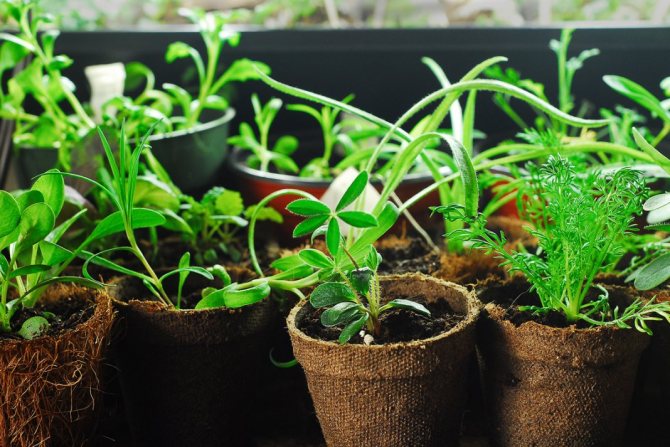
Seedlings of annual and perennial flowers. <>
Types of flower crops and planting dates
Seedlings can be grown in winter (January-February) or early spring. The time of planting seeds depends on the variety and type of plant, as well as on the rate of its growth and development. For example, winter planting is recommended for slow-growing flowers - petunias, snapdragons, ageratum and purslane, and spring planting for sweet peas and morning glories. Growing seedlings of flowers can be guaranteed to get amazingly beautiful and decorative flower cultures that will delight you with their lush and fragrant flowering throughout the summer. The main thing is that the basic rules for planting seeds and further care for seedlings are observed.
Seed preparation for planting and selection of capacity
The procedure recommended by experienced flower growers - seed soaking - is carried out using stimulating solutions "Kornevin" or "Heteroauxin" or ordinary cold water. Seeds with a hard hard shell must be soaked for about a day.
As a container, you can use plastic disposable cups, which are suitable for sowing large seeds, or shallow bowls with a large diameter for small seed material.
Soil preparation
The soil mixture for growing seedlings should be light and well permeable to air and water. The specialty store has soil for seedlings, but you can also take ordinary soil from a park or garden. True, before using it, you need to carry out preventive measures that will disinfect it. It is enough to hold the soil in a hot frying pan for just a few minutes.
Planting seeds
Each flower plant has individual requirements for planting seeds and must be studied and adhered to. But there are generalized rules that recommend sowing small seeds on the surface of wet soil and germinating in the light, and planting large seeds at a depth of at least 1 cm.
Which annuals have small seeds?
The seedling method of growing is well suited for flowers with very small seeds - ageratum, begonia, fragrant tobacco, bellflower, lobelia, snapdragon, mimulus, petunia, purslane ...
Seedlings of these flowers are very thin and weak, easily die in the open field, so seedlings are a guaranteed way to grow beautiful flowers.
When buying seeds, be sure to pay attention to the expiration date, read the information on planting on the bag ...
If small seeds need good lighting for germination, then large ones with a hard shell develop slowly and do not need light before germination. But, after the sprouts appear, you should move them to a bright place.
cm."Lobelia -" tricks "for growing seedlings"


Seedling care rules
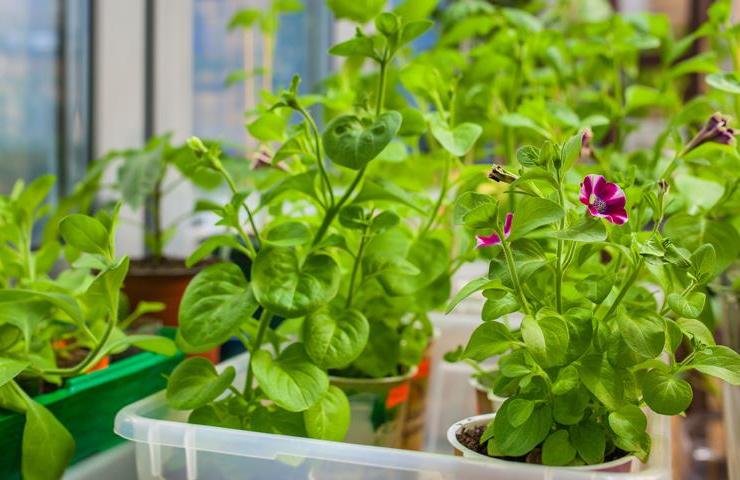

The place for growing seedlings should be in a bright, sunny room, but with diffused light.
The air temperature should be constant and not exceed the interval from 20 to 25 degrees Celsius. Temperatures below 18-20 degrees will delay germination. Direct sunlight will dramatically raise the room temperature and lower humidity levels. This can lead to the appearance of pathogenic bacteria and the onset of the disease.
Soil moisture is moderate, without excess moisture.
A shelter made of glass or thick plastic wrap will help create the necessary greenhouse conditions for germinating seeds and further developing seedlings. To obtain full-fledged young plants, you need stable air humidity and temperature, as well as daily ventilation and the absence of cold drafts. The number of airings should be increased gradually. The shelter can be removed after 3-4 full-fledged leaves appear.
Watering the seedlings is carried out regularly in moderate amounts.
The lighting is recommended to be very bright, but direct sunlight should not fall on the plants due to the danger of scalding delicate leaves.
The first transplant is recommended after the formation of 2-3 pairs of full-fledged leaves on the seedlings. So that young flower crops do not interfere with each other, thinning is carried out. This procedure is especially necessary for seedlings of those types of flowers in which the seeds are very small and are sown chaotically. The ideal distance between seedlings after thinning is at least 1-2 cm.
The second transplant of seedlings is carried out around the end of May. At this time, when the warm weather has already established, and the plants are not threatened by nighttime cold snaps with light frosts, the seedlings can be transferred to open flower beds. Strong healthy seedlings usually quickly take root in the open field and after a short time they begin to delight with their first blossoming buds, a bright unique floral aroma and a varied palette of colors and shades.
Zinnia
| Seed treatment | soaking before pecking (in a damp cloth) |
| Sowing dates | first half of April |
| Sowing depth | 1 cm, directly into peat pots or individual cells |
| The soil | standard |
| Lighting | standard bright |
| Temperature | 22-24 degrees |
| Seedlings | from 2-3 days when soaking |
| Dive | do not carry out, when the seedlings are pulled out, they are buried |
| Hardening | at the end of May, at least 10 days |
| Landing in the soil | first half of June |
| Landing distance | 30-35 cm |
| Difficulties | does not like transplants, adventitious roots are easily injured |
Marigold
| Seed treatment | like pre-germination on a damp cloth |
| Sowing dates | early April |
| Sowing depth | 0.5-1 cm, not thick |
| The soil | standard, drainage is laid on the bottom of the containers |
| Lighting | standard bright, shade until shoots appear |
| Temperature | 22-25 degrees before germination and 18-22 degrees for seedlings |
| Seedlings | from 3-7 days |
| Dive | only thickened seedlings, buried to the cotyledons |
| Hardening | 10 days before disembarkation |
| Landing in the soil | end of May - beginning of June, with a depth of several centimeters |
| Landing distance | from 20 to 40 cm |
| Difficulties | when thickened, suffers from a black leg |
Basil
| Seed treatment | requires stratification within 1 month |
| Sowing dates | all April |
| Sowing depth | 3-5 mm |
| The soil | standard |
| Lighting | standard bright |
| Temperature | room |
| Seedlings | from 7 days |
| Dive | when the second pair of leaves appears |
| Hardening | week before landing |
| Landing in the soil | June |
| Landing distance | 40 cm |
| Difficulties | blooms in the second year |
Morning glory
| Seed treatment | soaking for 1 knock with piercing of non-swollen seeds with a needle |
| Sowing dates | all April |
| Sowing depth | 3-5 mm |
| The soil | standard |
| Lighting | standard bright |
| Temperature | 18 degrees |
| Seedlings | 6-14 days |
| Dive | double, with full preservation of the earthen coma, in large pots |
| Hardening | week before landing |
| Landing in the soil | end of May-June |
| Landing distance | 15-20 cm |
| Difficulties | you need to install a support, does not tolerate a transplant |
Read our detailed material: "Growing morning glory from seeds"
Crops that are sown for seedlings in April without preliminary seed treatment:
Cochia
| Sowing dates | all April |
| Sowing depth | superficially, slightly pressing |
| The soil | nutritious standard |
| Lighting | as bright as possible, but diffused |
| Temperature | 18-23 degrees |
| Seedlings | from 7 days |
| Dive | after growing up to 5-7 cm |
| Hardening | a week before disembarkation |
| Landing in the soil | May, when kochii grow to 15-20 cm |
| Landing distance | 35-40 cm |
| Difficulties | need stable moisture, easy to stretch, afraid of root injuries |
Gelichrizum
| Sowing dates | first half of April |
| Sowing depth | 3-5 mm, straight into pots |
| The soil | light sifted |
| Lighting | bright |
| Temperature | room |
| Seedlings | from 5 days |
| Dive | do not conduct |
| Hardening | week before disembarkation |
| Landing in the soil | end of May - June |
| Landing distance | 25-30 cm |
| Difficulties | afraid of root injuries |
Scabious
| Sowing dates | early April |
| Sowing depth | 3-5 mm |
| The soil | standard |
| Lighting | standard bright |
| Temperature | 16-18 degrees |
| Seedlings | from 8 to 25 days for different species |
| Dive | after the appearance of the second pair of leaves |
| Hardening | in two weeks |
| Landing in the soil | the beginning of June |
| Landing distance | 25-30 cm |
| Difficulties | slow growth of seedlings |
Xerantemum
| Sowing dates | all April |
| Sowing depth | 3-5 mm |
| The soil | standard, can be directly into peat tablets |
| Lighting | bright diffused |
| Temperature | middle room |
| Seedlings | from 7 days |
| Dive | when the third leaf appears, 3 pieces in medium-sized pots |
| Hardening | 2 weeks before landing |
| Landing in the soil | late May or early June |
| Landing distance | 25 cm |
| Difficulties | very afraid of transplants |
Cotton wool
| Sowing dates | early April |
| Sowing depth | 3-5 mm |
| The soil | standard |
| Lighting | standard bright |
| Temperature | room |
| Seedlings | 10-15 days |
| Dive | at the stage of the second pair of leaves |
| Hardening | 10-14 days |
| Landing in the soil | At the beginning of June |
| Landing distance | 30-50 cm |
| Difficulties | no, hardy and simple plant |
Amaranth
| Sowing dates | all April |
| Sowing depth | up to 1 cm |
| The soil | universal, can be sown in a greenhouse |
| Lighting | standard bright |
| Temperature | room, not lower than 15 degrees |
| Seedlings | 4-5 days |
| Dive | after the appearance of the second leaf in peat pots or double |
| Hardening | week before landing |
| Landing in the soil | end of May-June |
| Landing distance | 35-50 cm |
| Difficulties | afraid of root injuries |
Helipterum
| Sowing dates | second half of April |
| Sowing depth | 3-5 mm |
| The soil | standard, sown in large boxes |
| Lighting | standard bright |
| Temperature | room |
| Seedlings | from 5 days |
| Dive | after 1-2 leaves in peat pots |
| Hardening | from 1 week |
| Landing in the soil | third decade of May |
| Landing distance | 15 cm |
| Difficulties | poorly tolerates transplantation and root injuries |
Godezia
| Sowing dates | all April |
| Sowing depth | 3-7 mm |
| The soil | light sifted |
| Lighting | standard bright |
| Temperature | room or greenhouse |
| Seedlings | 2 weeks |
| Dive | after the appearance of the second pair of leaves in pots of 3-4 plants |
| Hardening | 1 week before landing |
| Landing in the soil | second half of May - June |
| Landing distance | 15-20 cm |
| Difficulties | very afraid of transplants |
Plants that can continue to be sown in April:
- asters (first decade);
- dahlias (beginning of the month);
- letniki, whose flowering they want to delay in the second half of the season.
Supplementary lighting in April for seedlings of ornamental plants, as a rule, is not needed.The exception is extremely unfavorable cloudy weather, from which young seedlings may suffer. For them, when pulling, it is better to organize additional lighting.
Care that seedlings need in April:
- Daily removal of film or glass from crops.
- Start of active watering for growing seedlings (but you still need to control the moisture content of the soil and focus on the rate of its drying). Gentle moisturizing of young seedlings continues this month.
- Top dressing for cut plants and weakened seedlings.
- Accurate ventilation of the premises and increase the access of seedlings to fresh air.
- The first hardening procedures, taking the seedlings of the first sown plants to fresh air on warm days (start with a few hours, and then leave the plants for an increasing period until the night temperatures do not allow the plants to remain outdoors constantly).
- Continued formation for plants with bushy growth and a large number of shoots.
Other chores that are important not to forget about:
- Keep the seedling areas clean.
- Make sure there is enough soil and containers to cut all the plants.
- Organize convenient ways to carry the seedlings to fresh air, think about their movement and placement.
- Keep an eye on the weather forecast and temperature readings so that you don't miss the opportunity to start hardening early.
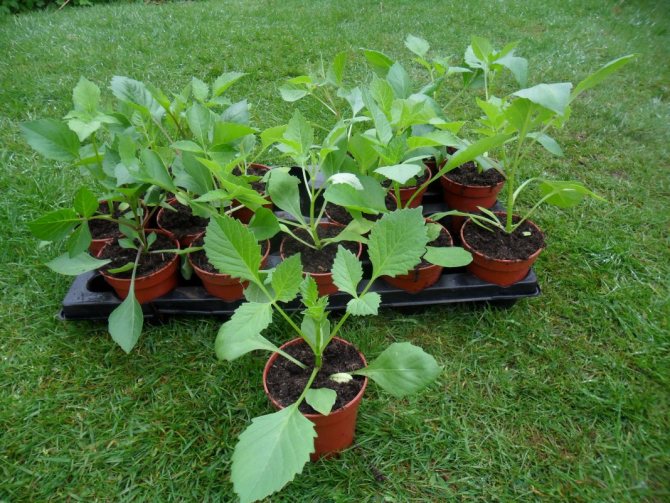

Dahlia seedlings
When to plant seedlings?
As a rule, seedlings are planted in January, February, March or April. Let's take a closer look at the features of planting seedlings in each of these months:
- Sowing seeds in January. In January, the Shabo carnation is sown, the flowering of which occurs 6 months after this procedure. Also in January, tuberous begonia is sown, which will delight with its first flowering six months after this action. If you sow begonias in December or January, the tubers will form much better and keep longer than those sown in March. As a rule, the seed bag indicates how long must elapse from the moment of sowing to the beginning of flowering. The longer the time period, the earlier it is necessary to sow the seeds. During this period, seedlings of flowers are sown, the seed of which must undergo mandatory stratification. These colors include the following: aquilegia, spring gentian and stemless, arizem, climate, booklet, swimsuit, rutnik, Jeffersonia, perennial violet, strawberry, alpine bell, irises, most bulbous flowers, lumbago, lavender, primrose. In addition, in January it is recommended to plant tightly similar perennial seeds that have a dense thick shell. This is done if for some reason you do not want to scarify the planting material.
- Sowing seeds in February. In February, the sowing of those flowers is carried out, which also differ in long-term germination. In the same month, you can sow Shabo carnations or flowering begonia. In addition, February is exactly the time when it is allowed to plant those plants that will feel pretty good both in the garden and at home. These plants include the following: fuchsia, lobelia, balsam, petunia, pelargonium. Also in February, the seeds of narrow-leaved lavender, sparkling salvia, vittrock viola and heliotrope are sown. In this case, it is necessary to take into account the fact that the seedlings of some plants need a long day of light, so you will have to organize additional lighting for it with the help of special lamps.
- Sowing seeds in March.For March, as a rule, they plan to grow seedlings of fragrant tobacco, echinacea, lobularia, verbena, climbing kobei, snapdragon, iberis, bluebells, matthiola, herbal cloves, climbing asarinas, as well as those flowers that for some reason were not sown in February. In the first half of the month, it is recommended to sow those flowers that can be grown both in the garden and at home. What colors are the following: kufeya, pelargonium, coleus. In the second half of the month, the following annuals are sown for seedlings: castor oil plant, phlox drummond, penstemon, celosia, annual aster, helichrisum, arctotis, alissum, venidium.
- Sowing seeds in April. In April, the following flowers are sown: marigolds, graceful zinnia, summer cypress, knifofia, aquilegia, amaranth, daisies, Suvorov's limonium, perennial delphinium, fragrant rose, annual dahlia, xerantemum, basil, calendula, willow herb, gipomea ... In addition, in April, you can sow seeds of those flowers that for some reason were not sown in March.
What to plant for seedlings in May
May is the month when most plants go through the hardening procedure and finally get the opportunity to take their place in the garden. True, active planting for most plants is possible only in the second half of May. In many ways, this month's work depends on the weather and its whims. A personalized approach is the best guarantee that you will not lose your seedlings through negligence.
Crops that are planted in open soil in May in the middle lane:
- cloves Shabo, levkoy, cineraria, sweet peas, all types of violets, as well as other annuals that belong to cold-resistant crops;
- seedlings of herbaceous perennials, cereals and other perennial plants;
- seedlings of herbs and ground cover;
- plants for potted gardens, containers, ampels.
Crops that are planted in open soil in May in the southern regions:
- all decorative annuals;
- all decorative perennials.
Care that seedlings need in May:
- Reduce watering, do not apply fertilizer to prepare plants for planting (but do not deviate from individual plant recommendations).
- Start or continue hardening the seedlings by taking them out into the open air, and in warm weather, leaving them there even overnight, about 10-12 days before planting in the soil. In the third decade of the month, start hardening the seedlings of heat-loving ornamental plants that you plan to plant in June. By this time, they should be outdoors. Watch out for recurrent frosts and on days of nighttime cold snaps, bring the plants indoors.
- Provide shading and stable soil moisture for the ornamental plants planted in the ground.
Since most of the seedlings must be transported to the site this month, do not ignore the organizational hassle and think about transportation and carrying in advance. Make sure you have enough pallets and shipping boxes, research how many plants you can transport at one time, and set up a schedule. The better you prepare, the easier it will be to deal with any problems.
Do not forget that the seedling planting sites need to be prepared in advance. Improve the soil in time, apply organic and mineral fertilizers, take care of the preparation of drainage materials. Store tools and utensils so that at a convenient moment you do not waste extra energy and time searching.
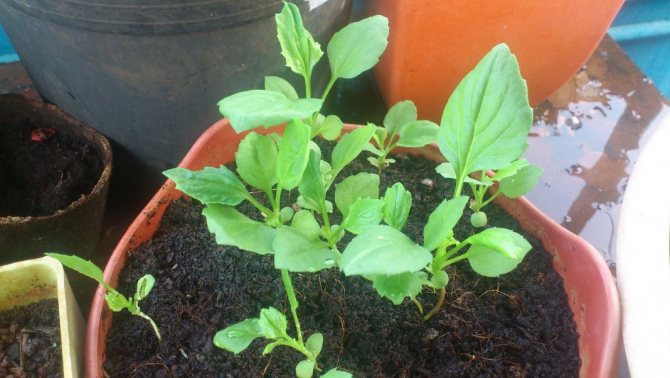

Seedling of asters.
How to grow seedlings?
Choosing seedling pots
First of all, the question arises about choosing a container for growing seedlings. If you choose between boxes and pots, then it is recommended to give preference to the pots, since this is how the seeds are sown in a separate container, without having to deal with picking seedlings in the future.In pots, planting material is not injured, and the risk of infection with rot is minimized.
As a rule, seedlings are grown at home on loggias or window sills, on which there is not so much space. If you are not a fan of the planting method, and you can get by with just a few containers for seeds, then it is recommended to use pots. Well, if you are planning to get a large number of seedlings, then you need to use plastic cassettes designed specifically for seedlings. These cassettes usually have pallets, otherwise they can be placed in cups or boxes.
It is strongly discouraged to use cardboard containers, especially from under dairy products, since they are currently being treated with substances that, evaporating, are capable of inhibiting hatched seedlings, which causes freezing and lack of development.
Peat pots
It should also be borne in mind that the seedling container must be environmentally friendly so that the plants do not experience any discomfort. It is best to purchase peat pots. Such containers have simple walls that provide moisture and air exchange in the root layer of the soil. When the seedlings grow up, they can be planted in open ground directly in peat pots, while the root system of young plants is not injured by extraction from the container. Such pots do not contain any toxic elements, pathogens. In addition, they are quite durable both dry and wet.
Peat tablets
There are also so-called peat tablets, designed specifically for growing seedlings, which swell when soaked, after which they form a glass that is filled with peat substrate.
The above containers are ideal containers for growing seedlings, but small plastic disposable cups and large boxes can also be used. The main thing in this case is to make drainage holes in the container, and put a pan for excess water under the bottom.
Sowing soil
The seedling soil must have the following qualities:
- Looseness;
- Ease;
- Porosity.
The substrate for sowing seeds should be good for air permeability and retain moisture. In addition, the soil must meet all the requirements of the particular crop that you are going to grow.
It is not recommended to use a substrate consisting of the following components:
- Compost and any kind;
- Leafy land;
- Rotten manure;
- Low-lying unprocessed peat;
- Wood shavings;
- Untreated sod land;
- Wood sawdust, varnished;
- Chopped straw;
- Hay dust;
- Quarry sand, not washed from clay;
- Not washed sea sand.
To compile the soil, you must use the following components:
- Horse peat;
- Weathered or pronounced low-lying peat;
- Crushed pumice;
- Expanded clay;
- Meadow sand or sandy loam;
- Granular foam;
- Sod land after heat treatment;
- Agroperlite;
- Sphagnum moss;
- Vermiculite;
- Chopped coniferous bark;
- Perlite;
- Dry needles;
- Quartz river sand;
- Grain husks;
- Crushed peanut shells.
You can also purchase ready-made soil mixture for planting seedlings in the store. In order to find the right one, you need to know exactly in which substrate the seedlings will grow better. In addition, it is necessary to study the composition of the soil offered in specialized stores.
It is imperative to pay attention to the composition of fertilizers that are included in ready-made soil mixtures. An excess of fertilizer in the substrate can interfere with the flowering of future plants.If the soil contains phosphorus, potassium and nitrogen in the range of 400 mg per liter, it is recommended to use it only as a component for seedlings or for picking seedlings. Sowing seeds in such soil is undesirable, since future seedlings will turn very green, and the buds will not form at the same time.
In addition, it is not recommended to use garden soil, since it is unbalanced with respect to the mineral composition, and also pathogenic microflora and pest larvae are observed in it. The ideal soil for growing seedlings is a substrate for cacti. But before sowing seeds, it must be adjusted for acidity, while adding dolomite flour.
Seedling lamps
Generally, the days in late winter and early spring are fairly short. For this reason, growing seedlings often do not have enough daylight for the full development of the day. To increase daylight hours it is necessary to use artificial lighting.
It is worth immediately excluding incandescent lamps from the list of backlights, since they are capable of generating a large amount of heat, and at the same time they do not emit the rays necessary for plants. For additional lighting, it is recommended to use energy-saving lamps or phytolamps.
If we talk about energy-saving lamps, then induction lamps are used for germinating seeds. Lamps with a warm spectrum are used to illuminate seedlings that are already in the flowering phase, while energy-saving fluorescent lamps are ideal for illuminating seedlings during the entire growing period.
Additional lighting lamps should be installed perpendicular to the seedling boxes.
Among the lamps, choose LED, sodium, halogen or fluorescent. Most often, the choice falls on the latter. This is due to the fact that such lamps produce almost no heat, but at the same time consume very little energy and have a full spectrum of colors. LED bulbs are very durable. They also have the ability to emit red and blue colors, which stimulate rapid plant growth.
Halogen lamps lose their level of heat transfer over time, so they are used quite rarely. Sodium lamps are most often used for additional illumination of seedlings in small volumes.
During the selection of phytolamps, you also need to consider which ones are more suitable for you: ceiling, wall or compact, which give a directed beam.
Having started growing flower seedlings from mid-January, you should provide the seedlings with good illumination, as this gives a good impetus for the development of sprouts and the healthy state of the plant as a whole. Flower seedlings grown from seed using the techniques below.
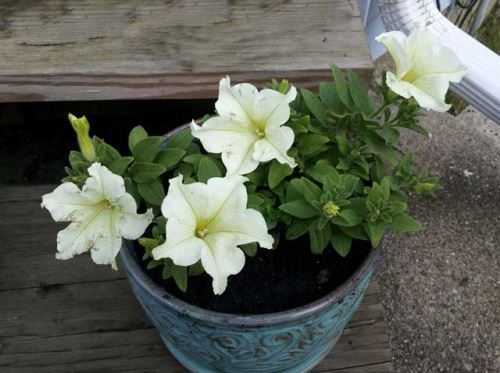

Annuals with a long growing season are grown through seedlings, since they simply will not have time to bloom if they are sown directly into open ground.
It is also safer to grow heat-loving plants with seedlings, then, when the threat of return frosts has passed, plant them in the garden. These include: marigolds, hybrid gatsania, cultural dahlia, Waller's balsam, balsam balsam, garden petunia, silver celosia, graceful zinnia, all types of nasturtium.
Some of the listed garden crops (marigolds, nasturtium, zinnia) can be sown in the ground, but then you need to cover the seedlings with non-woven material.
see "Growing houseplants from seeds"
Buying seeds
Here are some tips for growing strong and beautiful flower seedlings. Many of the most beautiful annual flowers in central Russia will not bloom if they are not planted for seedlings in March-April, or even in February. And you don't want to deprive yourself of the pleasure of admiring their beauty.
You can, of course, purchase seedlings in the spring, but it may not always be of high quality and of exactly those color combinations and varieties that you expect. In my opinion, it is better to tinker a little and grow your own flower seedlings.I want to say right away that the most beautiful and strong will, of course, be seedlings grown with love. When caring for seedlings, think with what bright elegant flowers it will decorate your garden by summer, imagine where you will plant it. But this, of course, is not the whole secret, there are subtleties, without knowing which mistakes can be made.
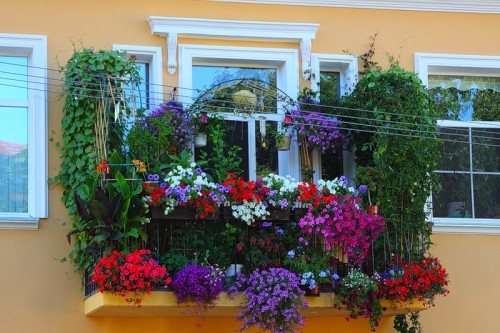

Seedling flowers
When buying seeds, be sure to pay attention to the expiration date and never buy seeds from the "markdown" section.
Daylight hours in central Russia are short in winter, so do not rush to sow seedlings, if the type of the selected plant allows it, sow it in April. But some flower seedlings need to be sown as early as February. In this case, so that the seedlings do not stretch out and become thin and weak, it is necessary to take care of supplementary illumination with fluorescent lamps of white or daylight. Supplementary lighting begins with the emergence of seedlings in the early morning hours and in the evening about 6-8 hours in February and about 4-5 hours in March. Sowing in a warm greenhouse - in the middle or end of April, depending on the weather.
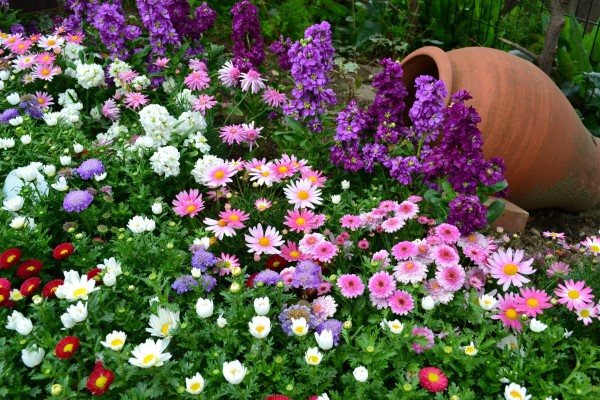

Flower seedlings
For the prevention of diseases, the seeds can be soaked for 5-10 minutes in a weak solution of potassium permanganate. The container for planting must be washed, scalded with boiling water and disinfected in the same solution or in a solution of bleach or copper sulfate, even a new one. It is not permissible to sow new seedlings in dirty containers with compost residues from last year's seedlings. Soil for seedlings, if it is not bought from you in a specialized store, it is better to ignite it in the oven, you can also freeze it or spill it with potassium permanganate.
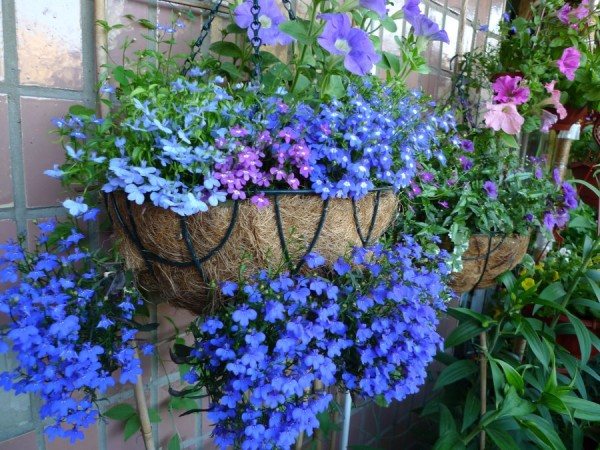

Flowers in pots
As a rule, the seed contains the primary supply of nutrients necessary for the initial stage of growth, therefore it is best to use compost with the addition of peat and sand for growing seedlings. For sowing, you can use flat ceramic pots, boxes, special disposable peat pots. A drain hole is required in any container. The dishes must be washed, even if they are fresh from the store. A drainage layer is laid at the bottom of the tank, this can, for example, be gravel or coarse sand. But it can be made easier, the bottom with drainage holes can be sent out with a piece of paper or newspaper. The primer can be used purchased or prepared independently. The distance between the surface of the soil and the edge of the container should be about 2 cm. The day before sowing, the soil is watered. The earth must quickly pass water. Be light and loose. Before sowing, the soil is lightly compacted with a palm or any even object. The soil is moistened again before sowing.
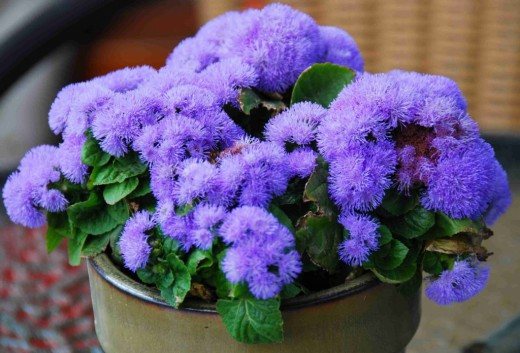

Ageratum
Currently, various growth stimulants are sold in specialized stores, why not take advantage of modern technology. Soak the seeds in one of the stimulants (epin, zircon, etc.) before planting, this will increase their germination rate and vitality.
The seeds are scattered over the surface. You can make grooves with a ruler (slightly pressing it with an edge into the ground) and sow the seeds in rows. You can mix the seeds with a little starch or chalk before sowing so that they can be seen on dark ground. Such sowing will avoid thickened sowing. After that, the seeds are covered with an even thin layer of earth, or left on the surface, depending on the agricultural technology of the plant.
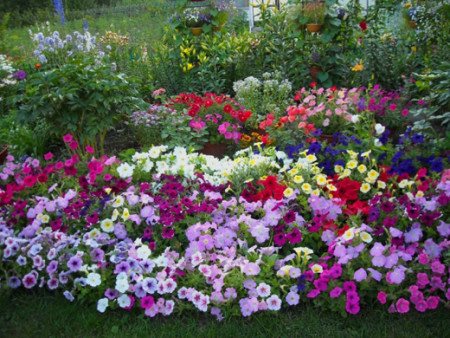

Growing flowers
Very small seeds (ageratum, begonia, lobelia, petunia, purslane) are mixed with sand 1:10 before sowing, after sowing they are not sprinkled with earth. The sowing plate is covered with glass or placed in a plastic bag, which is tightly fixed. And they put the bag in a shaded place.
Use the rule of thumb - the seeding depth should be equal to three times the size of the seed. After sowing, the soil is carefully moistened using a pulverizer and covered with glass or transparent film.
Read the bag fit information. There are some plants, the germination of seeds of which requires special greenhouse conditions, while others require stratification or scarification, some germinate only in the light, and others in the dark. If you are a beginner florist, it is best to avoid such plants with specific growing conditions for now.
Crops must be ventilated daily by removing and wiping glass or film. Before sprouting, the container with seedlings should be placed in a warm place with a temperature of about 20-25 degrees. Usually, the crops are not watered before emergence, usually the soil so retains moisture under the glass after planting.
For germination, seeds need a moist environment with access to air. In such conditions, the seeds collect water (swell), begin to breathe, biochemical reactions are activated in them, and after a certain time they hatch. In most of the annual flower crops, seedlings appear in 10-14 days.
Most likely, after 3 - 4 days, fresh seeds of the cruciferous family sprout - levkoi, lobularia, malcolmia, ornamental cabbage. However, seeds of morning glory, cobea, coreopsis, toadflax, snapdragon, molucella, nirembergia, salpiglossis, and Drummond phlox usually take only 20 days to germinate.
Just as long and, moreover, verbena shoots appear uncommonly. Germination energy and germination capacity decrease during storage of seeds. These indicators deteriorate especially rapidly at a critical time, when the period of natural preservation of these qualities ends.
Crops should be periodically ventilated. As soon as the sprouts hatch, the dishes are placed in the light. The polyethylene or glass is lifted, and after a few days they are removed completely. It is necessary to turn the dishes to evenly illuminate the seedlings with sunlight.
Watering at this time should be done with extreme caution, overflow is dangerous by the development of a black leg. Pour water at room temperature from a watering can with a fine strainer. When watering from a puller, quite often only the top layer becomes wet. It is better to water the seedlings less often, but more abundantly, than to often spray the top layer. But don't fill it up! Usually, in apartments with central heating, the air is very dry, so place a container with water near the containers with seedlings, this will help increase the humidity of the air.
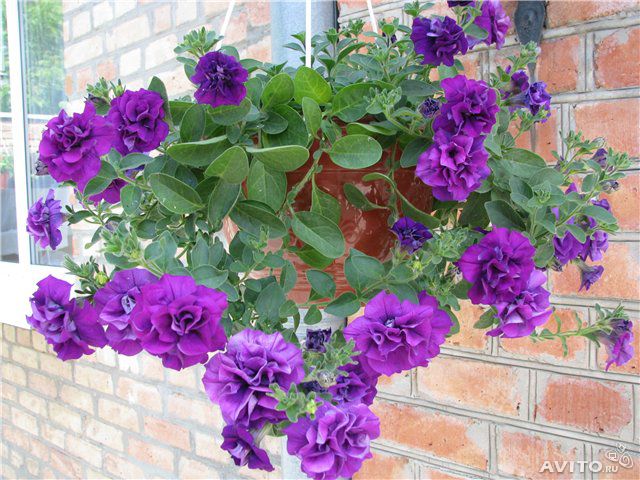

Terry petunia
Seed germination is influenced by temperature. The seeds of most of the annual flower crops hatch and sprout at a temperature of 20 ° C during the day, 16 - 18 ° C at night.
Heat-loving balsams, gatsania, dahlia, morning glory, cobea, nirembergia, pelargonium, tunbergia, celosia and sage germinate better at 22-24 ° C. Cold-resistant ornamental cabbage, levkoy, lobelia, lobularia, snapdragon, chrysanthemums, scabiosa prefer lower temperatures for germination - 14-16 ° C.
As soon as our seedlings hatch, the temperature is slightly lowered, for example, to 15-18 degrees and they are placed in a bright place, on a window, for example. This will prevent pulling and promote the growth and development of the root system.
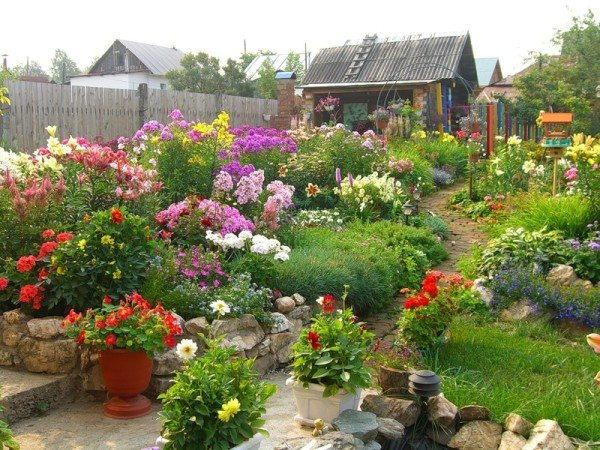

Flowers on the site
The light does not affect seed germination in most crops. They can be germinated both in the light with the obligatory shading from the direct sun, and in complete darkness. But there are a number of crops that require diffused light for seed germination, these are ageratum, Waller's balsam, lobelia, lobularia, snapdragon, mimulus, petunia, purslane and celosia. In contrast, complete darkness is required for germination of seeds of verbena, salpiglossis, phlox Drummond and schizanthus.
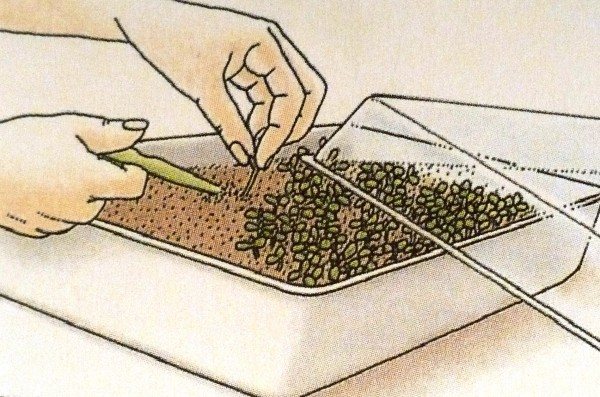

Seedling picking
Seedlings usually dive in the phase of 2-3 true leaves. To do this, they are carefully seated one at a time in separate containers - bowls with a diameter of about 9-10 cm. Before the picking procedure, the plants must be watered.
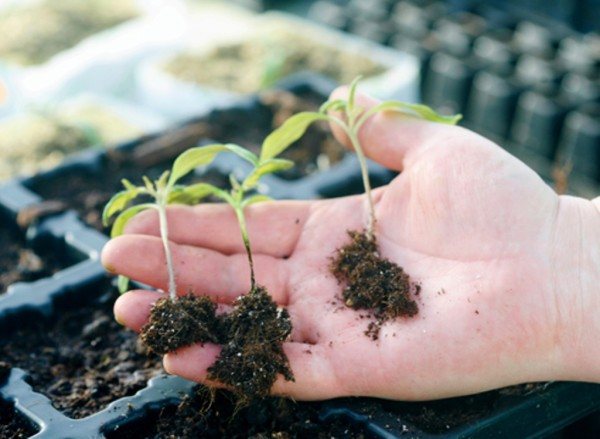

Blackleg
A black leg is when the bottom of the stem rots, becomes thin and dark. To prevent this disease, you do not need to water the seedlings with cold water, you do not need to water them too often, and you need to provide the plants with the same temperature. But if the plants are still sick, it is necessary to remove the diseased plants, and water the rest with a weak solution of potassium permanganate, and then do not water for several days. You can mulch the soil with a small layer of calcined sand, or with a mixture of sand and ash.
In order for the seedlings to be beautiful and strong, fertilizing is carried out with complex mineral fertilizers. Two dressings are enough, when the plants reach the phase of 2-3 true leaves and shortly before planting in open ground.
Before planting seedlings in open ground, it must be hardened. To do this, if the plants are on the windowsill, start opening the window more often, taking the seedlings outside in the daytime, or transfer it to a greenhouse for a start and open it for a day. Also, plants start to water less often. The hardening procedure usually takes about a week.
Seedlings are planted in a permanent place in late May - early June, when the threat of recurrent frosts has passed. Before removing the plants from the container, you need to water them abundantly and wait a little so that the water is absorbed into the ground. Plants are planted, observing the distance between them, indicated on the bag. During the first week, the seedlings are shaded and watered abundantly for better regrowth.
♦ Carefully study the biological characteristics of the culture. If you grow annuals - asters, salvias, tagetis, zinnias, dahlias, etc., be guided by the date by which you want to get flowers. If you want your flower garden to be the brightest and most attractive by the beginning of the school year, sow in mid-April, since most varieties of annual crops bloom about 80-100 days after germination, plus the time for survival after transplanting. In addition, aster is often grown with a pick and 3-5 days are added for the survival of seedlings. If we need flowering beds early, then we carry out sowing earlier. In this case, to save space, we grow seedlings with subsequent picking.
♦ The experience of many growers suggests that many annuals are easier to grow directly by sowing in the ground. To do this, it is necessary to prepare the soil in the fall and have a large supply of seeds, since germination in open ground is always lower. Not all aster varieties are suitable for this growing method, but only curb, semi-double, early ones.
♦ The seedling method also has to be chosen when growing flower crops with very small seeds - petunia, purslane, snapdragon, etc. The seedlings of these plants are so small and weak that they can easily die in the open field.
♦ The cultivation of perennial flower crops by the seed method has a number of features. In the first year, these plants do not flower, so early sowing is not necessary. The seedling method is used only with a small number of seeds in order to obtain and preserve as many seedlings as possible.
♦ If there are enough seeds, crops such as rudbeckia, Gaillardia, aquilegia, lupine, primrose, etc. can be sown on the beds from May to July. In the fall or spring of next year, they can be planted in a permanent place. Another thing is the cultivation of seedlings of biennial crops, for example, “pansies” - viola. If the seedlings are sown early in March, the plants will bloom in the first year.
You might be interested in:
Beets on weeds
We grow seeds of trees and shrubs
We grow peanuts in the country and at home
We grow a good harvest of carrots
Harvesting of wood is not allowed
The term for planting seeds for seedlings ...
In the last days of January - including February, you can start sowing seeds of the earliest crops for seedlings: Shabo carnations and ever-flowering begonias.Tuberous is recommended to be sown even earlier - the last days of December - until mid-January. In this case, the plant will bloom in the same year and will have time to form tubers.
- How to grow a Shabo carnation from seeds
- Spring sowing begonias for seedlings
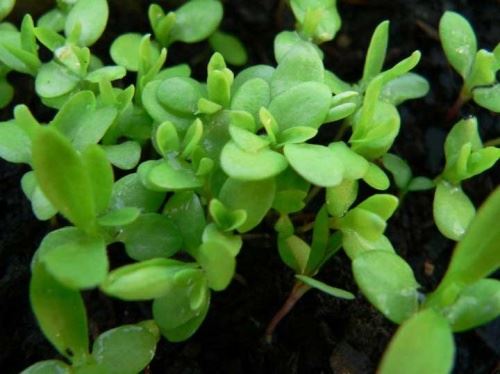

If it is not possible to provide constant illumination, then you can shift the planting to the end of February - the beginning of March, even if these are the seeds of the most "long-playing" flowers. Otherwise, you will get elongated weak plants, which are unlikely for the most part to survive until the happy moment of transplantation into the ground.
In February, a rather numerous group of flowers is sown on seedlings - New Guinea and Waller balsam, fuchsia, zonal pelargonium, ampelous pelargonium, cineraria, statice, viola, lipstick, salvia, lobelia, tigridia, passionflower, etc.
Pelargonium is usually sown in February to be planted in early June. Last season I sowed 20-23.01, bloomed after 24.05. It is better to plant grown seedlings in small pots - they will bloom more abundantly.
It takes about 3-3.5 months from sowing to flowering petunias, this culture blooms until frost. You can start sowing from the end of February or in March. Seedlings appear in 7-12 days.
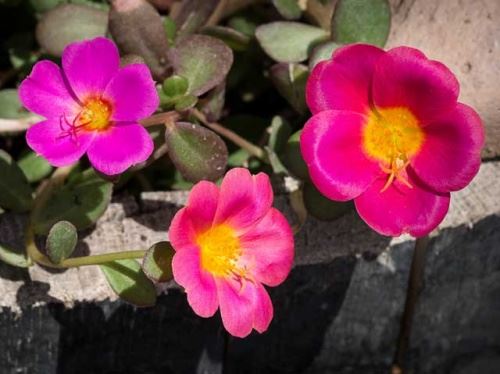

Mass sowing of one-year-olds most often begins only in March, which is associated with a short growing season.
In March, most annuals are sown for seedlings: asters, primroses, petunias, purslane, Drummond phlox, Chinese carnations, hybrid verbena, annual dahlias, milkweed bordered, snapdragon, anemones, levkoy, kupenes, cmin (immortelle), dolphin , sage, calceolaria, castor oil plants and those that were not planted earlier.
In the last decade of March, you can sow ageratum, alyssum, arctotis, gatsania, coleus, gelichrisum, sweet peas, cochia, lobelia, levka, perilla, salvia, scented tobacco and some other annual flowers, as well as most perennials.
In April, heat-loving and fast-growing flowers are sown on seedlings, which quickly sprout and develop - zinnia, iberis, amaranths, marigolds, nasturtium, balsam balsam, annual chrysanthemum.
It often happens that when sowing at home, some seeds do not germinate well or at all, but when they are greenhouse they will grow amazingly! In the greenhouse, you can grow wonderful seedlings of zinnia, ageratum, marigolds, balsams, iberis, phlox, godetia and some other types of summer plants.
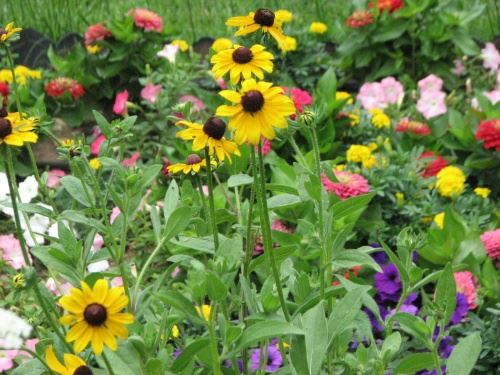

The sowing of many annuals, which we plant directly in open ground, on flower beds, flower boxes, falls on April-May (phlox, asters, nasturtium, marigolds, amaranth, decorative sunflowers, annual chrysanthemums).
What to plant for seedlings in March
The first calendar month of spring is definitely the main month for planting almost all ornamental plants. There is so much to do in March that it's easy to forget about the little things. Active crops should not distract from the care of seedlings and constant monitoring of their condition.
Crops that are sown for seedlings in March with pre-treatment of seeds:
Castor oil plant
| Seed treatment | soaking for 1 day |
| Sowing dates | all March |
| Sowing depth | 1-6 cm, immediately into large pots |
| The soil | standard |
| Lighting | standard bright |
| Temperature | from 12 degrees, standard room |
| Seedlings | from 8-14 days |
| Dive | if necessary transferred into large pots |
| Hardening | in two weeks |
| Landing in the soil | third decade of May - first decade of June |
| Landing distance | 1-3 m |
| Difficulties | prone to "sulfur leg", you need to remove the peel from the cotyledon leaves, very fast growth |
Dahlia
| Seed treatment | soaking for 10 minutes in a solution of aloe juice, fungicide or potassium permanganate |
| Sowing dates | all March |
| Sowing depth | 3-5 mm |
| The soil | standard |
| Lighting | standard bright |
| Temperature | indoor, for germination, preferably above 25 degrees |
| Seedlings | from 5 days |
| Dive | after 1.5-2 weeks, preferably in peat pots or tablets |
| Hardening | in two weeks |
| Landing in the soil | the beginning of June |
| Landing distance | from 30 cm |
| Difficulties | susceptible to disease |
Crops sown this month without seed treatment:
Violets
| Sowing dates | first decade or all of March |
| Sowing depth | 3-6 mm |
| The soil | standard |
| Lighting | standard bright |
| Temperature | 22-25 degrees |
| Seedlings | from 2 weeks |
| Dive | after the appearance of the second sheet |
| Hardening | in two weeks |
| Landing in the soil | in May |
| Landing distance | 15-20 cm |
| Difficulties | no, resistant plants, you can grow seedlings even at 10 degrees; plants tolerate transplantation well even in flowering |
Phlox Drummond
| Sowing dates | all March |
| Sowing depth | 1-2 mm |
| The soil | light sifted |
| Lighting | germination in shade, after germination - bright |
| Temperature | 18-21 degrees after sowing and cool (about 15 degrees) for germination |
| Seedlings | about 1 week |
| Dive | 2-3 weeks after germination |
| Hardening | from the end of April |
| Landing in the soil | May |
| Landing distance | 12-25 cm |
| Difficulties | prone to "black leg", you need to pinch after the appearance of 4-5 leaves |
Ornamental cabbage
| Sowing dates | second half of March |
| Sowing depth | 1 cm, in small pots or cells of 2 seeds |
| The soil | standard |
| Lighting | standard bright |
| Temperature | 18-20 degrees, then it is desirable to lower it to 12-16 degrees |
| Seedlings | from 2 days |
| Dive | after the appearance of 5-6 leaves |
| Hardening | in 2 weeks |
| Landing in the soil | late April and May |
| Landing distance | 50-60 cm |
| Difficulties | prone to black leg (watering before and after sowing, but then only with significant drying out) |
Asters
| Sowing dates | from mid-March |
| Sowing depth | 0.5 cm |
| The soil | standard nutritional |
| Lighting | additional lighting is desirable |
| Temperature | 18-20 degrees, then - not lower than 15 degrees |
| Seedlings | from 8-15 days |
| Dive | after the formation of the first pair of true leaves |
| Hardening | preferably from April until disembarkation |
| Landing in the soil | third decade of May or early June |
| Landing distance | from 10 cm for low, up to 40 cm for high grades |
| Difficulties | subject to "black leg", does not tolerate the deepening of the growth point |
Verbena
| Sowing dates | all March |
| Sowing depth | superficially, on the sand |
| The soil | sandy |
| Lighting | bright standard |
| Temperature | from 20 degrees, likes bottom heating |
| Seedlings | from 5-7 days |
| Dive | after the release of the second sheet |
| Hardening | preferably from April until disembarkation |
| Landing in the soil | second half of May, June |
| Landing distance | 20-35 cm |
| Difficulties | need stable humidity |
Ageratum
| Sowing dates | the end of March |
| Sowing depth | 3-5 mm |
| The soil | standard |
| Lighting | standard bright |
| Temperature | room |
| Seedlings | 14 days |
| Dive | double, 1 week and 3 weeks after germination |
| Hardening | in two weeks |
| Landing in the soil | June |
| Landing distance | 15-20 cm |
| Difficulties | variation in colors, sensitivity to dampness and stagnant air |
Lobularia
| Sowing dates | all March |
| Sowing depth | 3-5 mm, rarely |
| The soil | universal |
| Lighting | bright |
| Temperature | coolness or room rates |
| Seedlings | 4-10 days |
| Dive | at the stage of 2 leaves, with rare sowing, do not carry out |
| Hardening | May |
| Landing in the soil | 15-20 cm |
| Landing distance | from 15 cm for multi-flowered, up to 30 cm for ampelous |
| Difficulties | vulnerability to powdery mildew in dense crops |
Celosia
| Sowing dates | the end of March |
| Sowing depth | 5-7 mm |
| The soil | standard |
| Lighting | standard bright |
| Temperature | room indicators |
| Seedlings | from 12 days |
| Dive | double, first in boxes, then - in individual containers |
| Hardening | in two weeks |
| Landing in the soil | late May-early June |
| Landing distance | 15-20 cm |
| Difficulties | sensitivity to waterlogging |
Scented tobacco
| Sowing dates | all March |
| Sowing depth | superficially, without covering |
| The soil | standard |
| Lighting | bright |
| Temperature | standard room |
| Seedlings | 10-12 days |
| Dive | double (second sheet and after 2 weeks) |
| Hardening | 1 Week |
| Landing in the soil | May |
| Landing distance | 20-30 cm |
| Difficulties | no, resistant plants |
Also in March, snapdragons, levkoy, coleus, kobei, herbal cloves, venidium, alissum, asarin, brachycoma, glue, penstemon are sown on seedlings.
Plants that you can continue to sow in March:
- lobelia (first decade);
- petunia (first and second decade);
- pelargonium;
- other annuals of the February sowing, the flowering of which they want to postpone to a later date.
Perennials that prefer March sowing: Iberis, Sycamore, Echinacea and all plants in which the stratification period ends in March.
In the southern regions, in April, you can start planting seedlings of annuals and perennials in the soil, with the exception of the most thermophilic species.
Additional lighting in March is desirable, but not required. If the weather does not indulge in sunny days, and the seedlings show signs of insufficient lighting, then it is better to start supplementing the plants in a timely manner. It is advisable to pay special attention to this issue at the beginning of the month.
Care that seedlings sown in January will need:
- Daily airing of seedlings under glass or foil.
- Gentle watering with control of soil moisture. If you accidentally overflow, do not hesitate and immediately take measures to sand the substrate, reduce soil moisture.
- Top dressing to strengthen seedlings and stimulate growth (carried out only after full adaptation of the cut plants).
- Pinching and other shaping methods for bushy plants.
- Sprinkling soil when pulling seedlings or signs of compaction.
- Closely examining plants and responding to the slightest signs of problems detected.
Other chores that are important not to forget about:
- Continue preparing the substrate and containers at your leisure.
- Do not forget to organize the information and carefully note the procedures performed.
- Prepare a place on the balcony or where you plan to take the seedlings out on warm days for stabbing.
- Start preparing containers and means of transporting seedlings to the site, think over what and how you will transport it.
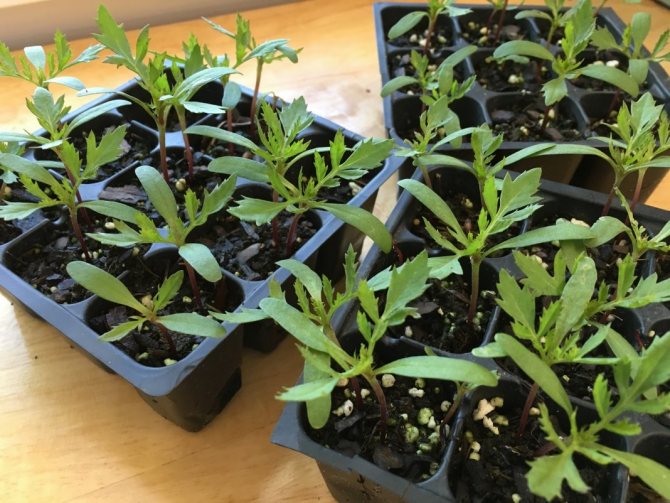

Seedlings of marigolds. <>
Growing seedlings of petunia seeds.
A few days before sowing, water the soil with Fitosporin-M for the prevention of black leg. If petunia seeds are pelleted, spread evenly at a distance of 1-1.5 cm and press them to the soil for better contact.
see "How to properly sow petunias for seedlings"
Sowing ordinary petunia seeds does not take place by embedding them in the soil, but by distributing them over the surface. You can mix the seeds with a small amount of river sand, do not sprinkle it with earth. Cover the container with a lid creating a greenhouse effect. Temperature range in containers is 20-22 ° С.
From crops of petunia, open the container lid in order to remove condensate from it. As for airing, in no case should the temperature and humidity change so dramatically. Watch the soil so that it is not dry, however, do not allow waterlogging either. When the seedlings of petunia grow up, you can gradually accustom it to the open air.
After the growth of a real leaf, the seedlings dive at a distance of 3 cm from each other. The plant tolerates picking and transplanting easily. I plant it in the flower garden after the threat of the night cold has passed.
When growing aster seedlings, the contrast in temperatures helps the seeds germinate faster.
In March - early April, I begin to sow the seeds of annual asters. From sowing to the beginning of flowering, 90-140 days pass. I sow early flowering varieties a little later.
Growing asters from seeds, planting seedlings and further care ...
I practically do not sprinkle the seeds slightly pressed into the surface of the moist soil.Having covered the crops from drying out, I put the box with them in a bright place for germination. This technique greatly increases their germination (after 5-6 days). When the first two true leaves appear, the seedlings can be dived. As a rule, this occurs on the 10th day after sowing the seeds.
Sometimes I use another method of sowing asters: I sprinkle the seeds on top with snow (1 cm layer) on top of the seeds. That's all - the snow melts and pulls the aster seeds into the ground. With this sowing, an imitation of aster sowing occurs in the fall before winter.
The temperature contrast allows the seeds to germinate faster. I sow aster on the surface of the earth. I put the crops in the refrigerator overnight, put them in a warm place during the day - and so on several times until the seeds hatch. Then I put them in pots, sprinkle with earth and water.
At first glance, this method seems to be a lot of "problems", but then you do not need to plant seedlings (although the aster is not afraid of transplanting), and the survival rate from such planting is higher.
Shabo carnations - growing flower seedlings.
A large selection of seed mixtures will produce flowers of the most interesting colors. You can plant until mid-February. Flowering will begin 150 days after planting, which will continue until frost. And shoots appear in 5-6 days.
Seeds of carnations are sown in rows, sprinkle with sifted earth on top and sprinkle gently with a spray bottle. Cover the box with polyethylene. Shake off any condensation as it fogs up. Seedlings will appear in 7-10 days at a temperature of 23-25 degrees.
Remove the plastic and place the drawer closer to the light. As the seedlings grow, add soil to the stems of the plants, since the young seedlings of carnations are weak and fragile.
After the first pick, I keep the boxes with seedlings at a temperature of 12 degrees. During the second - I pinch the seedlings in order to get more lush bushes. I plant seedlings in open ground only in the second half of May at a distance of 20 cm from each other.
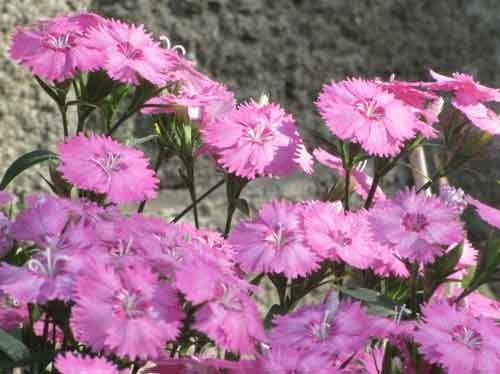

Types of annual flowers for summer cottages
Flower beds and flower beds look very beautiful when the plants are planted correctly and with love. In order to admire the flower arrangement from spring to late autumn, you need to choose plants taking into account their flowering dates, sizes, colors, growing conditions.
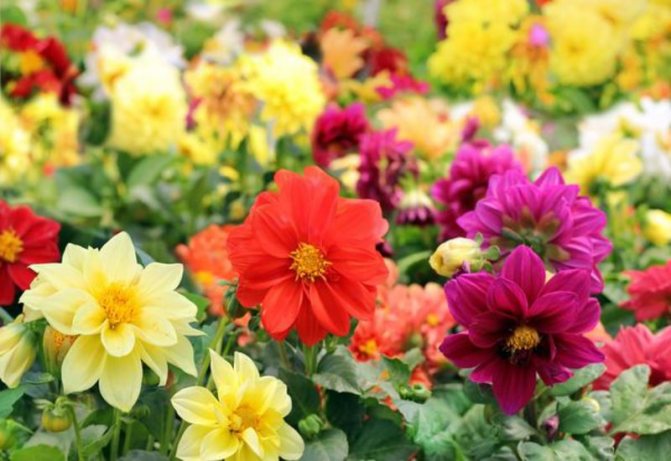

Now you can buy even the most unusual varieties of plants. The whole variety of colors is divided into two groups:
- perennials.
- annuals.
Basically, perennial plants bloom in early spring, delight with their exuberant flowering, and then fade, losing their attractiveness. In order for the flower bed to delight with its flowering all summer, it is necessary to plant annual plants, the flowering period of which is from June to the very frost.
One-year-old flowers are also called short-lived annuals. They die off after several months of flowering, they need to be planted annually.
In spring or early summer, you can choose for planting any plant from a rich set of annual flowers and decorate your corner. Annual flowers for the garden are unpretentious and long-flowering: garden aster, blue cornflower, kosmeya, Chinese carnation, petunia, tree heliotrope, sparkling salvia, graceful zinnia, snapdragon, nasturtium, balsam and others.
Bright marigolds
Marigolds are a very common annual. Blooms from May to October. Depending on the variety, it can be dwarf up to twenty centimeters, and it can grow up to a meter in height. It is an upright bush with numerous feathery green leaves and numerous flowers of yellow, red, orange, red-brown and other variegated colors.
It is advisable to plant marigolds in a sunny place in fresh soil rich in nutrients. It is good to frame flower beds with low-growing varieties.
Sow seedlings in February and March, in April you can sow in the ground in the beds.
Caring for marigolds is simple, it consists in moderate watering, feeding once a month, wilted flowers must be regularly cut off.
Calendula officinalis
Calendula is an erect, low-branched plant, the leaves are oval oblong, the flowers are simple or double orange, yellow, apricot, the center is dark.
It grows in height from thirty to sixty centimeters. Flowering time is from June to October.
Looks beautiful in groups on beds with red and white flowers, for example, salvia, cornflowers, snapdragons, chamomile.
Planted on any normal permeable soil. In dry times, it is necessary to water, with normal compost there is no need for additional fertilization, regular removal of wilted flowers promotes long flowering.
Annual sunflower
The sunflower is a sturdy, upright plant. There are low-growing varieties up to forty centimeters in height and tall ones that can grow up to two meters. The leaves are large, rough, heart-shaped. Inflorescences are yellow, reddish-brown, orange in color, the middle is dark. The flowering time is from July to October.
The sunflower is very beautiful and interesting in small groups, the bright flowers are suitable for decorating the background, in front of fences and walls. It is advisable to plant in a warm place protected from the wind. The plant has a high need for watering. Tall varieties must be tied to a support.
Lobelia Erinus
Lobelia is an erect or sometimes creeping bush, up to twenty centimeters high. The dense leaves are small, narrow, dark green in color.
A huge number of flowers of pink, blue, purple, cream, sometimes with white centers. Grown through seedlings, dived not one by one, but in bunches. It is necessary to plant in the ground in mid-May on a permeable, humus soil. Due to its ability to grow as a bush or to creep, it is very effective under or in front of taller flowers, good as a flower bed frame.
Uniform watering and feeding once a month will ensure flowering until frost.
Chrysanthemum bush
There are several varieties of annual chrysanthemums. The yellow multi-stemmed chrysanthemum has fleshy bluish-green leaves. White marsh chrysanthemums have pinnately complex green leaves, white inflorescences have a yellow center.
It grows in height up to forty centimeters. Blooms from May to October. They are beautiful in the beds, when framed by flower beds, like flower islands on a lawn. Unpretentious in care. Routine watering and removal of wilted inflorescences.
What to plant for seedlings in June
Biennials begin to sow seedlings in June (on seed beds and greenhouses). But the main front of work in the first month of summer is associated with the transfer of the most thermophilic plants to the garden.
Crops that are planted in open soil in June:
- the most heat-loving annuals;
- plants with lush flowering for quick decoration of the site.
The care that seedlings and planted plants will need this month should be intensified. After transferring to a permanent place for the adaptation of the plant, it is necessary to provide additional watering and monitor soil moisture. The most sensitive and capricious crops may need short-term shading. Do not start feeding immediately, even for lush summer plants: let the plants adapt and use the resources of the soil. Do not forget to install supports in a timely manner and tie up plants that need it.
Planting methods
The time of planting and planting annual flowers for giving is different for different regions of our vast country. In the southern part, letniks can be sown directly into the ground, as for the northern regions, later planting of seedlings is more suitable, which can be bought in specialized stores or grown on a windowsill or in a greenhouse.
Planting annuals in the ground
Cold-resistant summer plants, such as marigolds or cornflowers, can be sown in the garden beds as early as April. Here are some conditions for the successful planting of annuals in the ground:
- High quality seeds give you even, healthy seedlings. It is better to purchase them in specialized seed stores. When buying, you need to pay attention to the intactness of the packaging, on the date of packaging and shelf life, information on growing conditions. If in any doubt, consult your dealer.
- Soil preparation plays an important role in planting. Digging a site for sowing, loosening, removing unnecessary roots and stones, applying fertilizers is another condition for success when planting seeds in the ground.
- You need to sow the seeds correctly. For this, when sowing in rows, shallow parallel grooves are made, the distance between which depends on the seeds and the type of plant. The depth of the furrow is from two to four centimeters. Large seeds should be planted at some distance from each other. Spread the small pieces evenly with your fingers.
- When planting seeds, do not apply a thick layer of soil.
- After planting, the soil must be well watered with a watering can with a fine sprinkler.
- Dense seedlings must be thinned out by removing weaker seedlings.
How to sow flower seeds correctly?
After filling the seedling boxes with the nutrient mixture, pour over the hot pink solution of potassium permanganate. It is undesirable to apply any fertilizers, as flower seedlings often suffer from excess salts.
Do not forget about the drainage holes so that excess liquid flows out of the container. When the soil dries slightly, start sowing seeds.
Seeds are sown in rows at a short distance from each other, slightly pressed into the ground, falling asleep with a thin layer of soil. The exception is plants whose small seeds germinate in the light. In any case, they should not be buried too deep in the ground. After sowing, the soil is carefully moistened using a spray bottle and covered with glass or transparent film.
So, the seedlings have sprouted, and in the amount that you have planted! As soon as these seedlings grow up that you can grab them with your fingers, the stage of picking begins.
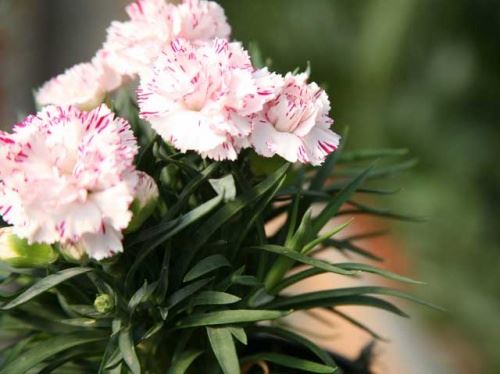

How to feed petunia for abundant flowering
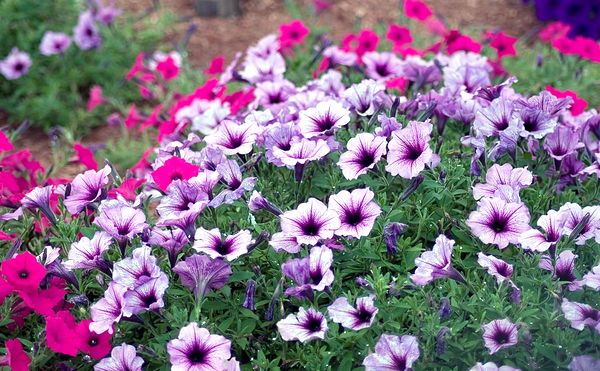

It is useful to spray already adult petunia plants, which have set buds and are ready to bloom, with a 1% boron solution to stimulate flowering.
For root dressing every 10 days, fertilizer formulations with a predominance of phosphorus and potassium are used. For example, drugs are diluted according to the instructions:
- "Crystalon pink",
- "Planton",
- "Aquarin".
If the dose is halved, you can feed on the leaves by spraying the drug with a sprayer.
The Kristalon preparation (pink and brown) helps to make the flowering longer, and Aquarine enhances the color saturation of petunia flowers.
You can use the alternation of dressings with potassium monophosphate, potassium nitrate and Fertik plus fertilizer throughout the season.
Fertilizer "Kemira Lux" is popular among gardeners; during the flowering period it is excellent for petunias. Has a ratio of elements (nitrogen-phosphorus-potassium) - 16:20:27. Agricola has a similar composition (15:21:25), an equally well-known preparation for dressing.
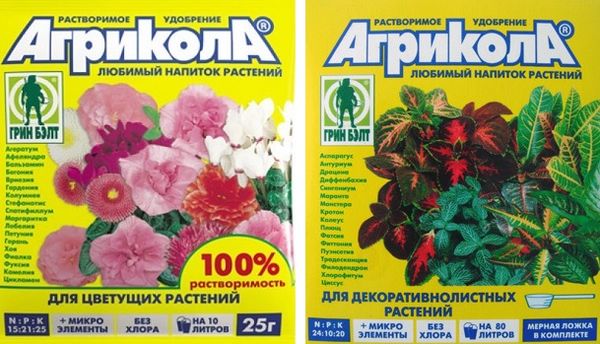

To get large flowers, it is useful to spray petunia on the leaves with Epin or Zircon preparations (concentration 1 to 15) once a week.
Spraying with potassium humate has a positive effect on the beauty of petunia flowers.
Fertilizer for spraying leaves is always diluted with water twice as weak as for root feeding.
If petunia leaves turn yellow
Sometimes gardeners are faced with yellowing of petunia leaves. Often this ailment is associated with a lack of iron. You can help the plant by treating the bushes with Ferovit.
Three-time treatments, with an interval between spraying of 7-8 days.
Sowing dates of annual plants in central Russia
| Seed sowing time | Plant name |
| First half of March | Anemone, aster, anacyclus, seaside armeria, asparagus, adonis, Chinese carnation, gomphrena, kupena, kufeya, lacfiol, mirabilis, mesembriantemum, euphorbia bordered, nolana, pyrethrum, sanvitalia, scabiosa, platavicodelios , soapwort, edelweiss, sage, immortelle. |
| Second half of March | Ageratum, arctotis, climbing azarina, brachycoma iberisolistnaya, venidium, herbal cloves, helichrizum, godetia, dolichos, morning glory, cleoma, lavatera, summer levkoy, lobularia, nasturtium, nemesia, osteospermistemoncema, eelichrisum, flaxispermonema, eelichrizum echium. |
| First half of April | Arctotis, annual aster, basil, cottonweed, helipterum, iberis, knifophya, xerantemum, lobularia, fragrant mignonette, scabiosa. |
| Second half of April | Amaranth, marigolds, annual dahlia, datura, diastia, sweet peas, decorative cabbage, clarkia, purslane, celosia, zinnia. |
How to choose a container
Gardening stores have a large selection of containers for sowing flower seedlings:
- Seedling boxes with low sides,
- Containers divided into blocks (plastic),
- Peat tablets,
- Plastic cassettes,
- Individual pots.
Many growers use plastic seedling cups.
For sowing annual flowers, it is recommended to buy special seedling boxes, in which you can plant several copies of flowers at once. In this format, it will be convenient to care for the seedlings. For picking, they are divided into individual containers. If the variety of flowers is particularly whimsical, then it is initially planted in a peat tablet, isolating it from other specimens. In this case, cups with a nutrient medium are also excellent.
How to plant annual flowers for seedlings - tips and tricks
Many gardeners grow annual flowers for open ground in the apartment building and in the country, deciding not to buy seedlings, but to do everything with their own hands. It is simple enough and less expensive or economical.
In the middle lane, a large number of flowers are grown by seedlings.
Acquiring seedlings with sprouts, even 10 plants of each individual species, is an expensive event, but growing from seeds for a personal plot is quite simple.
In addition, a seed dropped into the ground gives life to a future beautiful plant, which, growing up, will make the world more spectacular - is it not happiness for an amateur gardener.
When to plant flowers for seedlings?
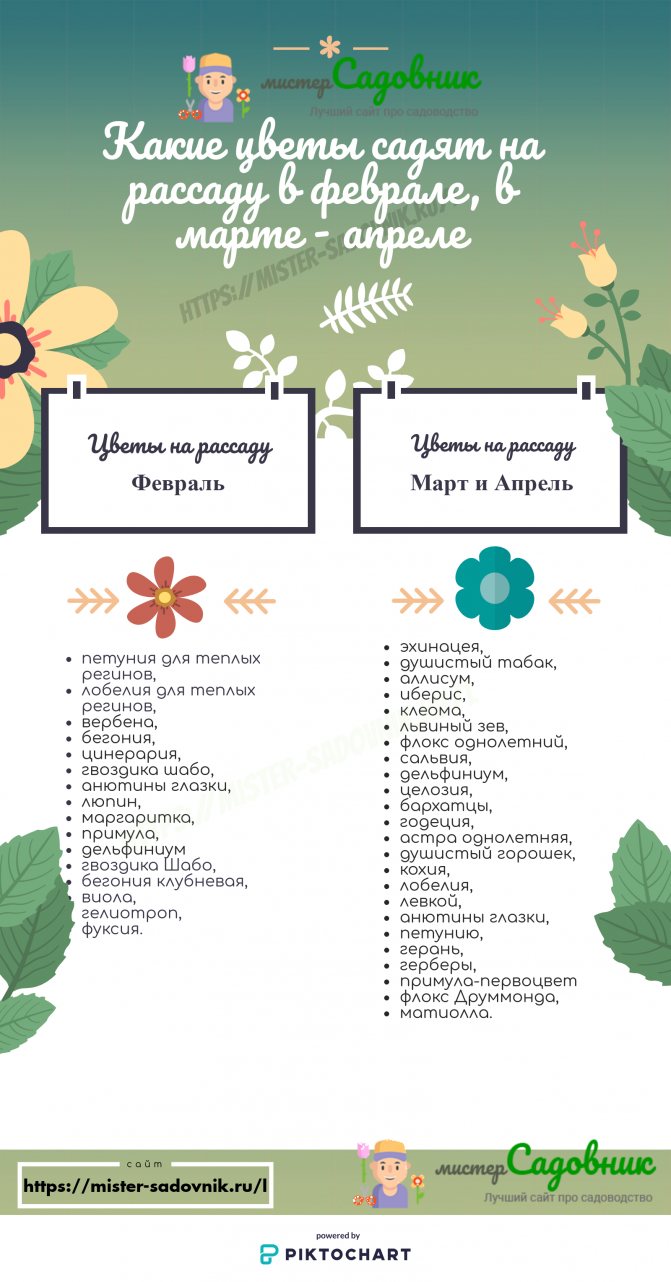

What kind of soil is suitable for growing seedlings of annual flowers?
It is important that the soil for seedlings is of good quality.
What kind of soil is suitable for growing annual flowers?
There are no tricks for sowing.
The seeds have a lot of energy to germinate, so, especially if you pre-treat the material with growth stimulants, standard soil from a specialized center is suitable for sowing.
Neutral slightly acidic peat must be mixed in equal proportions with clean river sand (sold in the store).
You can make a 3-component sowing soil - peat / leaf earth / sand in equal proportions.
A drainage layer must be laid at the bottom of the seedling container.
What are the seedlings grown for annual flowers?
Seedlings of annual flowers should be sown in special containers of suitable size.
This is the second point in the list of things required for growing seedlings, you should not just buy containers, but choose the right one.
In the store today you can find the following containers for flower crops:
- Pot.
- Box.
- Container.
- Plastic cassette.
- A pot of peat.
- Tablet, etc.
Any of the variety of containers for seedlings has both pros and cons, depending on the material from which the container is made, its size, and the stage of use.
How to choose seeds for annual flowers?
In addition to the correct selection of the ornamental crops themselves, which are better grown by seedlings, you should know how to choose the right seeds.
However, there is such a thing as the time of emergence:
- if the time has come to sow it is pointless;
- the seeds will grow poorly or not at all;
- those that ascend will be weak.
What kind of annual flower plants are grown by seedlings?
For a balcony, summer cottage or garden plot, for seedlings, followed by planting in the ground, the following crops of annual flowers are sown:
When are the seeds of annual flowers sown for seedlings?
- What flowers are planted for seedlings in February:
In February, annuals are planted in greenhouses with heating or in indoor conditions on special shelves with light installations, which have the longest development period in seedlings:
- Shabo carnation,
- tuberous begonia,
- viola,
- heliotrope,
- fuchsia,
- lobelia for warm regions,
- petunia for warm regions.
- What flowers are planted for seedlings in March:
In March, seeds of the following flowers are sown on seedlings: salvia, delphinium, celosia, gatsania, godetia, gelchiziu, annual aster, sweet peas, kochia, snapdragon, lobelia, alissum, levkoy.
You can sow pansies, petunias, geraniums, gerberas, Shabo carnations, verbena, primrose primrose and Gaillardia, Drummond phlox in March.
- What flowers are planted for seedlings in April:
Seedlings of species such as marigolds, zinnias, amaranths, annual dahlias, coleus, celosia, annual chrysanthemums are sown in boxes on the windowsill in mid-April, and planted in the ground at the end of May, when the threat of return frosts has passed.
The timing of sowing annual flowers in our country is approximately as follows:
- In the south of the country - March 1-15.
- The middle band is March 20-25.
- Ural and Siberian territories - from March 25.
Lunar calendar 2019 for planting flower crops
In February:
What is the best way to feed seedlings and at what time?
It is generally accepted by gardeners that the most suitable fertilizers for seedlings are complex, that is, they contain all three most important and familiar components, but this is not always justified, because in the soil, especially acquired, however, in the garden too, one or a couple of these elements is already perhaps, and as you know, an excess of fertilizer is hardly any less dangerous than a lack of it. Therefore, we advise you to feed your plants with dressings that contain only one important substance in their composition.
Direct application of fertilizers for seedlings containing potassium, phosphorus or nitrogen should be carried out early in the morning, when it is rather cool outside the window and in the room. When adding nutrition to the soil during additional feeding of plants, it is extremely important that fertilizers do not leave drops on the leaves of the seedlings or on its stems, because under the influence of the sun's rays in the future, burns may form on these places, that is, the stems and leaves, which is negative will then affect the general development of a particular seedling plant.
Planting flowers in the country
After the question of when to plant flower seedlings in 2020 has been decided, you need to decide on the correct planting of flowers. Plants are planted in mature soil. Squeeze a handful of soil in your hand - it should be moist enough to form a lump, but at the same time it should crumble if you drop the lump on a hard surface.
Most often, we plant flowers at home in the spring, and then transplant the flower seedlings to the garden, to the flower bed. Compared to buying seedlings, growing summer and biennials has two advantages: this method is cheaper, and the choice of species and varieties of seeds is much wider.
Look for flower varieties labeled as F1 hybrids - these are first generation hybrids that have more vitality than regular varieties and more attractive flowers. Some perennials can also be grown from seeds, but this requires a lot of time and certain skills.
When planting small plants, the planting hole is covered with soil removed from the same hole. For sprinkling the roots of larger plants, it is better to prepare a planting mixture of 1 part sod land, 1 part wet peat and 3 handfuls of bone meal per wheelbarrow.
Further care
Despite the unpretentiousness of annual flowers, their seedlings need some care:
- Watering. Watering seedlings 1 time in 2-3 days. If the room is too warm, then watering is increased up to 1 time per day.
- Illumination. If there is little light in the room for keeping seedlings, they purchase a special lamp, with which they replenish the required level of illumination.
- Temperature. It is necessary to maintain the temperature at least 22 degrees. For this purpose, you can use a heater and a humidifier (so as not to dry out from heating).
- Top dressing. The first feeding is done 2 weeks after germination. It consists of mullein solution. It is diluted in water in a ratio of 1:10 and the soil is cultivated (1 glass is enough for 10 plants). The same procedure is repeated after 2 weeks. This solution can be replaced with bird droppings and ash.
If the above recommendations are followed, healthy and strong plants will grow, which successfully adapt to open field conditions.
The effectiveness of fertilizing and increasing yields
The effectiveness of any top dressing for flower and horticultural crops depends not only on the method of application, but also on compliance with the recommended dosages. First of all, it should be borne in mind that seedlings of flowers or vegetables are fed with a less concentrated solution than adult plants. This requirement applies to ready-made mineral dressings (peroxide, saltpeter, etc.), and to folk remedies (infusion of onion peel, yeast, aloe juice and others).
If you exceed the dosage, the plants will receive too much nutrition and may suffer from it. Therefore, before using any tool, carefully read the instructions, and when using folk remedies, follow the advice of experienced gardeners and gardeners.
Seed preparation for sowing
Experienced growers recommend preparing seeds for planting. For various diseases, it is advisable to soak the selected material in a weak solution of potassium permanganate for 10 - 12 hours.
For early germination, the seeds can be soaked (according to the instructions) in a solution of zircon or epin.
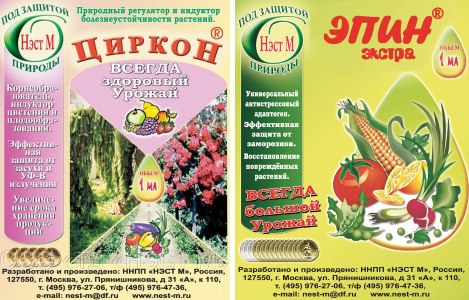

Many seed growers undergo a stratification procedure. For this, flower seeds are soaked in ordinary water for about 12 hours. Next, the dishes with seeds are removed to a cold place for the same time. Then the container is again brought into the room, then into the refrigerator, and so on until the seeds germinate. Experts say that in this way, plants, even at the embryonic stage, acquire immunity to possible temperature extremes.
General sowing rules
Any plant has its own requirements for growing conditions, but there are some general rules that combine the procedures for sowing seeds of any flowers. Most experienced gardeners, of course, are familiar with these nuances, but a beginner will be interested in learning about them.
To begin with, you should take care of the inventory that you may need to successfully complete the procedure. These are all kinds of containers for sowing seeds, diving seedlings. In order not to spend extra money, which, as you know, is not such, you can take care of the containers in advance and have time to collect a lot of cans from food and drinks. These containers may well make a good container for flowers.
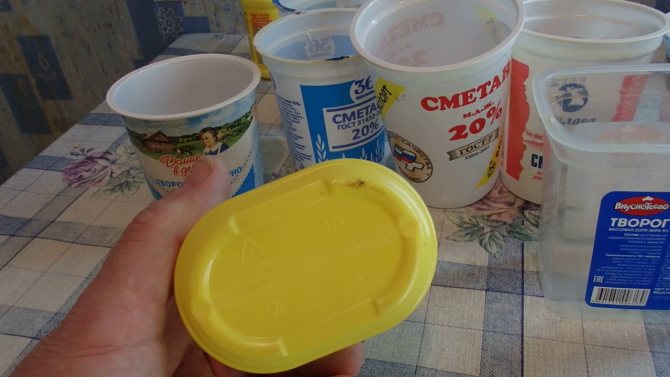

Plastic food containers are ideal for flower seedlings.
Also, without fail, you will need soil for sowing. It can be either a store-bought mixture or one made with your own hands on the basis of garden soil. The main thing is that the soil undergoes preliminary preparation, which will be discussed later.The soil mixture purchased in the store should be focused specifically on growing flowers and contain humus, peat, sand. The soil from your garden must be kept in the cold and only before direct processing is brought home - thus, it will be possible to kill all living organisms in it, including the larvae of all kinds of parasites. The purchase of fertilizer can be another step to success.
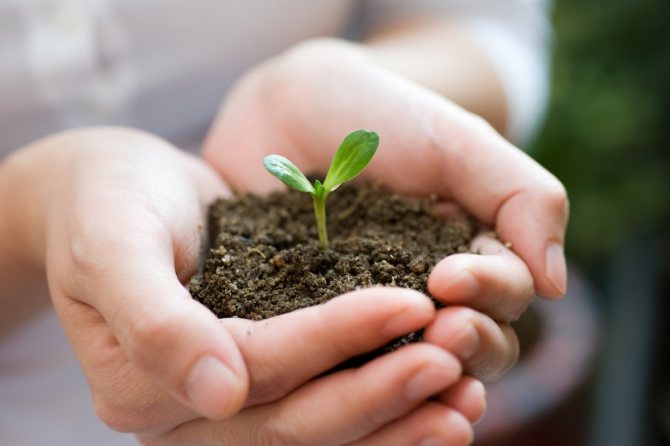

Soil for flower seedlings
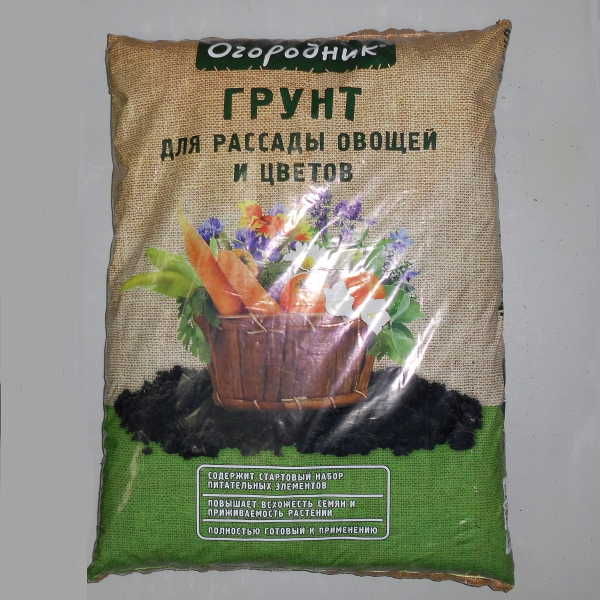

Soil for seedlings of vegetables and flowers
For watering the soil with sown seeds, it is better to purchase a spray bottle - it will not wash out the soil and will not disturb the flower seeds, which are usually very small. The grown seedlings can be watered with a watering can with a thin spout.


Spray
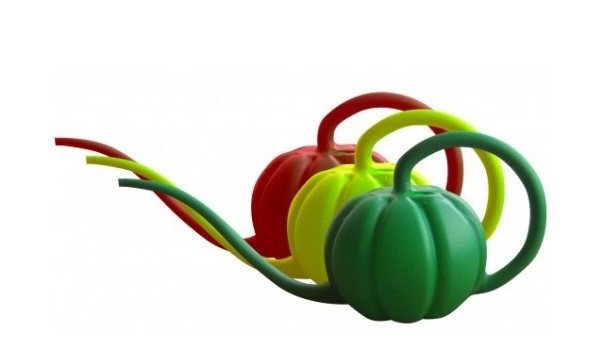

Watering can for flowers "Pumpkin", 1 l
On a note! Before sowing seeds, take care of the labels with the names of the varieties you will be growing.
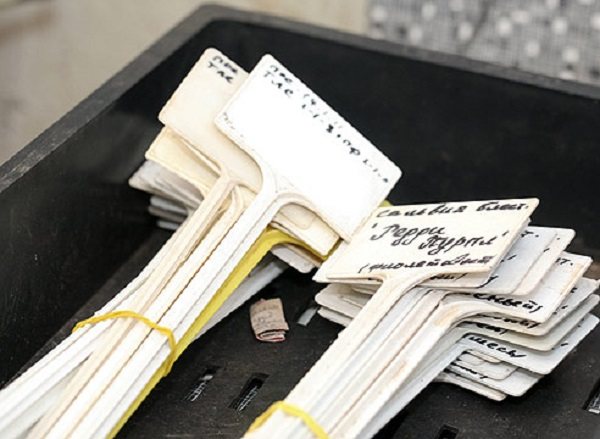

Labels for marking plants from handy
Seed selection
The future state of flowers depends on the correct choice of seeds. If the seeds are not of high quality, then seedlings may not appear at all. If they germinate, the plants will be susceptible to disease.
For the correct choice of seeds, you need to follow the recommendations:
- The purchase of seeds for seedlings of annual flowers should be carried out only in proven places. It is better to give preference to purchasing goods in supermarkets. There he goes through a thorough quality control.
- It is best to take advantage of gardeners' reviews and purchase seeds from a trusted company.
- Do not take goods with a damaged bag or without identification marks in the line "manufacturer".
- Before choosing seeds of a particular variety, it is important to read about its characteristics. There is a chance that the gardener will not be able to provide the flowers with the necessary conditions. This may be due to the peculiarities of the climate of the region, high soil moisture at the site.
If you follow the above rules, the likelihood of bad shoots will be significantly reduced.
Seedling picking
Picking - moving a plant into a separate container, in which it grows and develops rapidly. In annual flowers, it is carried out when the seedlings are overgrown with 3-4 leaves.
Pick steps:
- The day before the operation, the soil is intensively moistened by watering the seedlings.
- Prepare the container, fill it 1/3 with soil.
- Seedlings are taken out together with a lump of soil and placed in a container.
- The seedlings are covered with an additional layer of soil.
- Place the pots with transplanted seedlings in a shady place for 2-3 days.
After picking, the seedlings need to be hardened, gradually reducing the temperature in the room. After that, you can take it outside (you should start at 10 minutes).
Choosing seeds
Before you go to the store for seeds to start growing flower seedlings (after all, you really want to see beautiful flower beds in your country house), you need to familiarize yourself with those varieties and species that need to be grown in seedlings. Indeed, in fact, many of the flowering plants have time to grow and bloom during the summer simply from seeds sown in the ground.
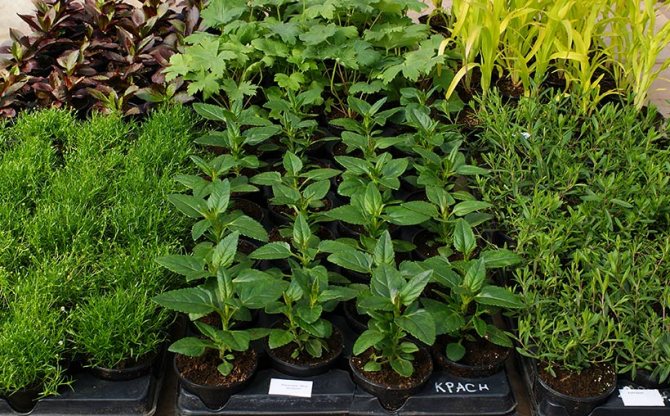

Seedling flowers
So, both perennials and annual plants with a long growing season can be cultivated by the seedling method. They can also be planted on seedlings if the owner of the backyard dreams of a blooming garden at the beginning or middle of summer. In general, absolutely any flowers can be grown by seedlings, if there is a desire for the dacha to look like a flower bed during the entire horticultural season.
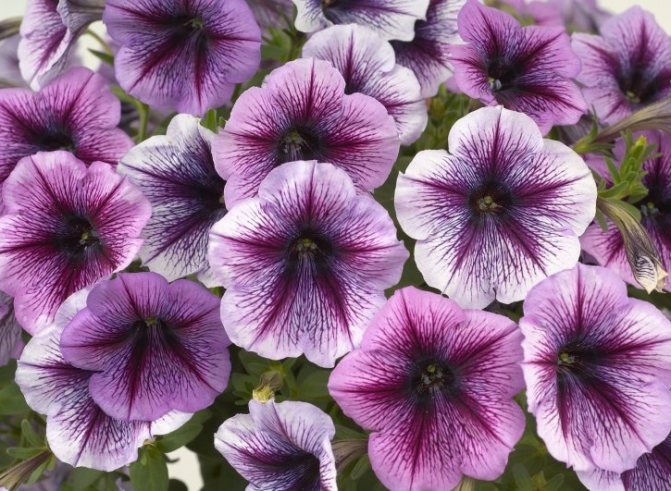

Petunia
But there are plants that are sown for seedlings more often than other crops; in particular, these are:
- petunia;
- lobelia;
- gerbera;
- ageratum;
- nasturtium;
- marigold;
- phlox;
- begonia;
- zinnia;
- Snapdragon.
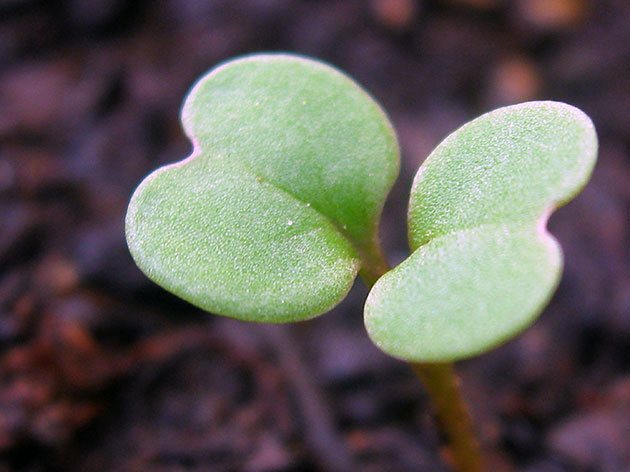

Seedling flowers
There are also other species and varieties that need seedlings.In any case, for this you need seeds, which can be harvested with your own hands at the end of last season, or purchased from gardening stores. And here, too, you should not lose your vigilance: cunning sellers may try to slip you, as an inexperienced summer resident, low-quality material that may not come up at all. To prevent this from happening, carefully study the packages with seeds, carefully read the expiration dates.
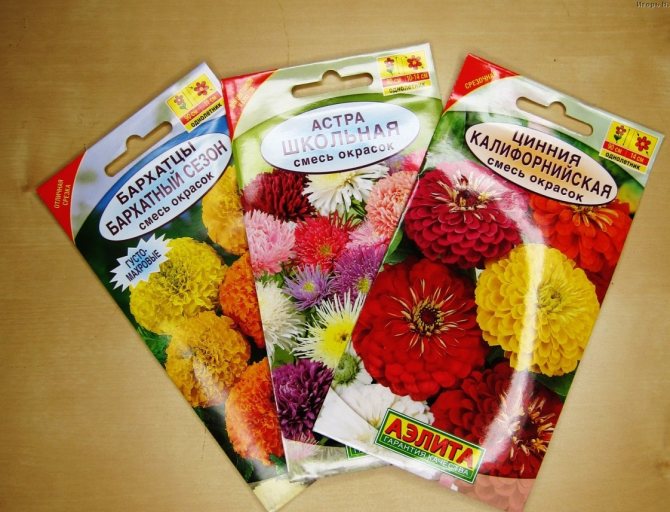

Flower seeds in packages
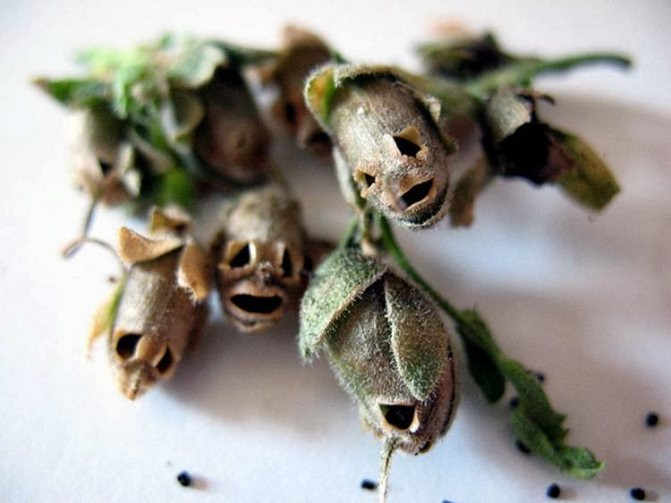

Snapdragon - seeds
On a note! It is best to buy the freshest possible flower seeds - so there is a greater chance that they have good germination. Unfortunately, over time, they lose this quality. Ideally, if the seed sale period ends no later than the end of the current year or next.
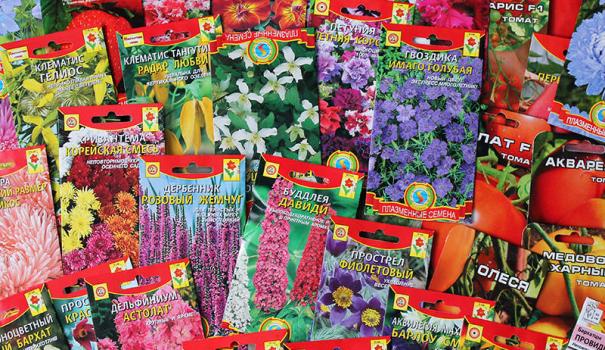

Flower seeds
It is also advisable to make a choice in favor of those seed producers about whom you know at least something. It is undesirable to purchase seedlings that are packed in incomprehensible and damaged bags, even if they are offered at a large discount.
It is important to evaluate the growing conditions that the flowers you choose need. Familiarize yourself with these conditions and choose those crops that can provide the necessary amount of sun, shade, moisture, and also make them exactly the flowerbed on which they will be comfortable.
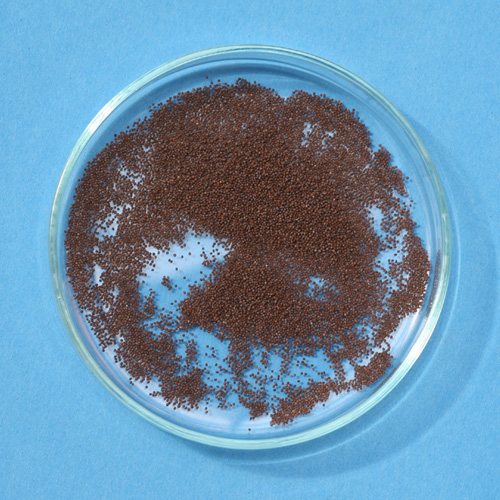

Natural petunia seeds
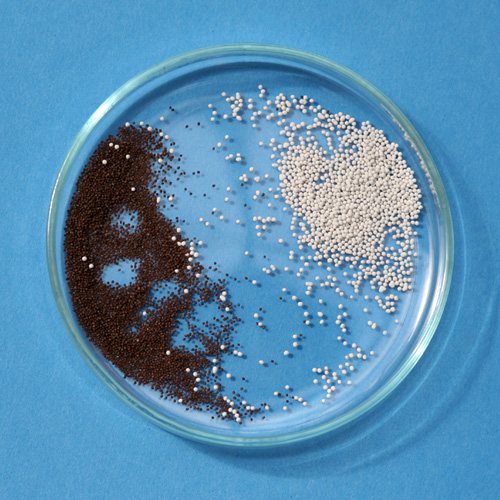

Natural petunia seeds and petunia granules
On a note! In shaded areas, lobelia and balsam perfectly take root. And they are not afraid of short-term drought of nasturtiums, marigolds, phloxes. A long-blooming flower is a petunia that can delight you every day and for a long time, therefore it is considered the queen of country flower beds.
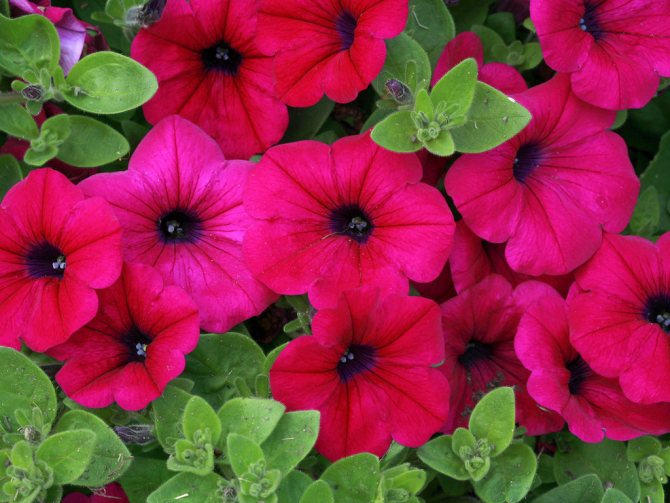

Petunia - the queen of the flower bed
Petunia seed prices
petunia seeds
Growing primrose - flower seedlings.
We send primrose seeds to the refrigerator for freezing for a month, and in March we plant them in containers.
Primrose, like petunia, is sown on the surface of the earth, without sprinkling, in plastic containers with lids, thanks to which a moist environment and enough light for crops are preserved, make sure that the sun's rays do not fall on the crops.
Grow seedlings using the same technology as petunias. You need to handle the seedlings very carefully - the roots are very weak!
Choosing a place for seedlings
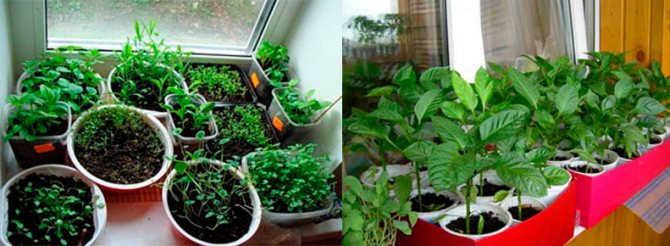

When growing seedlings of flowering plants, remember that seeds must be germinated in the dark. Having planted the seeds, the container with the seedlings is placed in a dark place. But when the first shoots appear, the containers with seedlings are rearranged into the light. There will be little natural light in late winter - early spring. To fix this, it is necessary to illuminate the seedlings with fluorescent lamps. Daylight lamps are turned on during the daytime. This will help the young seedlings maintain a balance of day and night. The ideal place for growing seedlings is a mini-plant. She can be found at the flower shop. But there is one drawback in using it - it takes up too much space. Improvised means will correct this situation. The container with future seedlings is covered with glass. After the seeds have germinated, a kind of greenhouse is built by pulling a piece of polyethylene between two pieces of wire.
Pros and cons
Whether the hassle of growing seedlings is worth your time and labor, we will find out.
Minuses
- The main disadvantage of preparing flower seedlings is high labor costs. This is a rather troublesome business, therefore it is often unprofitable for busy flower growers.
- Another minus - if the garden plot is large and a lot of flowers are required, then the seedlings will take up significant areas. And if, in addition to flowers, seedlings of tomatoes, cucumbers, and other vegetables are still needed, then you will have to give almost a separate room for pots.
- After carrying out the picking work, a thorough cleaning of the premises may be required.
- Failure to comply with the rules of cultivation and care leads to obtaining seedlings weak, frail, unviable.
pros
- If you sow seeds correctly and properly care for the seedlings, the quality of home seedlings is much higher than that of the purchased one.
- Flowers obtained from seedlings bloom much earlier than those that were planted immediately in the garden. Thus, the decorative period, for which, in fact, flowers are grown, is significantly extended.
- Seedling flowers suffer much less from weeds, since they are planted in the ground outside already strengthened and with developed immunity.
- In the northern, cold regions, many flowers simply cannot be obtained without first germinating seedlings.
- Growing seedlings with your own hands is much cheaper than buying ready-made seedlings.
Useful tips on how to feed petunia seedlings
- Fertilizers are liquid, granular and in the form of sticks, which are immersed in the soil. It is most convenient to use liquid fertilizer. Since at any time you can change the concentration and amount of applied fertilizers. In addition, it is distributed more evenly in the soil.
- Petunia responds very well to leaf fertilization, that is, to irrigate the bush. Through the leaves, it absorbs nutrients much better.
- For seedlings, the fertilizer solution is made weaker than for an adult plant.
- Do not forget that for seedlings it is important not only to apply fertilizers and dressings, but also to have proper watering and temperature conditions.
What flowers are sown for seedlings
First you need to figure out for yourself which flowers can be propagated by seedlings. These include both annual and biennial plants and perennials. Of the annual flowers, seedlings are most often sown with those that have a long growing season, or if you want the flowers to bloom early. In principle, you can grow seedlings of any flowers, except for those that do not tolerate transplanting well.
Most often, seeds of such flowers are sown on seedlings: Shabo carnation, lobelia, petunia, cineraria, snapdragon, sweet peas, zinnia, marigolds, nasturtium, kosmeya, calendula, mignonette, geranium, gerbera, Gaillardia, viola, pansies, balsa, primrose , begonia, verbena, ageratum, aster, clarkia, phlox, levkoy, salvia, godetia, lupine, lavatera and many others.


